Paul Finch's Blog, page 15
February 8, 2017
Human monsters from a world of darkness
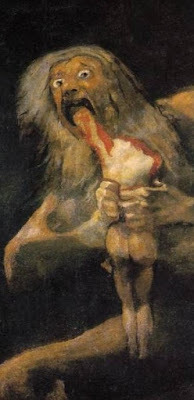 Okay, we’re talking serial killers this week – not exactly a new experience for regulars on this blog, I suppose.
Okay, we’re talking serial killers this week – not exactly a new experience for regulars on this blog, I suppose. But today we’ll be looking at two particular instances of fictional monsterdom: the indescribably terrifying psychopath who haunts the pages of Helen Fields’s new novel, PERFECT REMAINS, which we’ll be reviewing and discussing in full detail, and also the two-handed trail of slaughter and destruction that a pair of rival madmen wreak in my forthcoming Mark Heckenburg novel, ASHES TO ASHES.
I’ll also be reprinting a blog I wrote for GRAB THIS BOOK back in September last year, when I was posed the seemingly simple question: ‘If you had to meet a serial killer, how would you go about it?’
But, first things first. PERFECT REMAINS is a really excellent addition to the fictional serial killer canon. I strongly suspect that its author, Helen Fields, will pretty soon rank among the superstars of the genre. However, as always, my detailed analysis of the book can be found at the lower end of today’s post. Shoot on down there straight away if you wish. But if you’re interested in hearing stuff about Heck as well, hang around here for a bit first.
The most immediately important thing to day about ASHES TO ASHES is that a free sampler – approximately 29 pages of the final, finished text – is now available on Amazon. The book is published on April 6, but if you just can’t wait that long and you want to get a quick snifter of it without having to pay, then I recommend you call in HERE .
For those who are too impatient even for that, here is a quick outline:
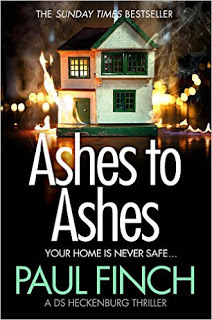 The Serial Crimes Unit is hunting a professional torturer called John Sagan, a man who is literally a
The Serial Crimes Unit is hunting a professional torturer called John Sagan, a man who is literally a travelling roadshow of atrocity. He cruises the country, taking his mobile torture chamber with him, and for a not inconsiderable fee he will happily introduce it to anyone a client nominates – though for the most part those he lures into his ‘Pain Box’, as he calls it, are underworld figures who have defied their paymasters and thus are being officially punished. As such, it’s taken a long time for word to get out that Sagan even exists. However, once Heck and the rest of SCU are informed, they go after him full-tilt – only for their first attempted interception to end in disaster, especially for one highly valued member of the team.
Now doubly determined to nab the highly-paid sadist, they pick his trail up again, but this time it leads them to the very last place Heck would have expected or wanted: his grimy northern hometown, Bradburn.
 (As a quick aside, I’ve been asked several times now if Bradburn is my own hometown, Wigan, which occupies a similar place on the border between Greater Manchester and Lancashire. The answer is a simple and straightforward ‘no’. Bradburn, though fictional, is Bradburn. The fact that that I recently did a special introduction to the book, and a reading of it in Wigan Central Library – and here’s the photographic evidence – is entirely coincidental).
(As a quick aside, I’ve been asked several times now if Bradburn is my own hometown, Wigan, which occupies a similar place on the border between Greater Manchester and Lancashire. The answer is a simple and straightforward ‘no’. Bradburn, though fictional, is Bradburn. The fact that that I recently did a special introduction to the book, and a reading of it in Wigan Central Library – and here’s the photographic evidence – is entirely coincidental). (On a not-unrelated topic, I'll be doing another of these book events at Blackwell ’ s bookshop, Edinburgh, on Wednesday Feb 15, in company with HELEN FIELDS herself, so keep that date in your diary free).
Anyway, Bradburn, a drab, post-industrial blot on the Northwest English landscape, is a town already in a state of terror. A gang war has erupted between local drugs-dealers and a more powerful mob from nearby Manchester, resulting in a succession of tit-for-tat killings. In that regard, it’s probably a natural hunting ground for John Sagan, who will hire himself to the highest bidder but who, as he enjoys inflicting horrific and agonising deaths on his victims almost as much as he enjoys getting paid for it, is a serial killer in all but name.
 And the frightened town’s problems don’t end there. The underworld battle has also attracted another nightmarish figure who will slay for pay – an armoured and helmeted maniac whose murder weapon of choice is a flame-thrower, which perhaps explains his nickname: ‘the Incinerator’.
And the frightened town’s problems don’t end there. The underworld battle has also attracted another nightmarish figure who will slay for pay – an armoured and helmeted maniac whose murder weapon of choice is a flame-thrower, which perhaps explains his nickname: ‘the Incinerator’.Bradburn has never seen anything like this carnage. In truth, Heck has never seen anything like it. Perhaps they can pull together and face this double-headed challenge side-by-side?
But then again, perhaps not.
As those who’ve read the Heck books prior to ASHES TO ASHES will know, Heck and his hometown don’t get on. There are deep wounds there. More than once in the past, Heck has commented that he wouldn’t mind if the entire place was reduced to ashes. Well, who knows … this could be that very moment.
*
Since the publication of my last novel, STRANGERS , which pitted a young undercover policewoman, Lucy Clayburn, against that rarest of criminals, a female sex-killer, I was grateful to be invited to participate in a number of crime-writing blogsites, to pen a little essay in each case about a different aspect of my work – the way I approach it, my research methods, and so forth.
This is always an enjoyable experience, but sometimes it can be a challenge. Take, for example, this question I was asked last September by GRAB THIS BOOK .
If you had to meet a serial killer, how would you go about it?
It’s a fascinating question. Where would you arrange to meet a serial killer, to interview him (or her) if you had the opportunity? Well, assuming you ever wanted to do that, the location is certainly something you’d have to give considerable thought to.
Even meeting such a person in the controlled environment of a prison would be no guarantee of safety. Far from it.
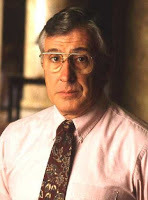 In the 1980s, Robert Ressler (pictured right) was a senior FBI agent who’d investigated a number of serial murder cases. Around this time, he began to devise what we know today as Vi-Cap (or the Violent Criminal Apprehension Programme), which required him to get into the minds of repeat violent offenders and attempt to understand their motivations. As part of his mission, he interviewed numerous multiple murderers in US jails. One particularly disturbing story he later told involved an encounter with a 6ft9in convict who’d killed and decapitated ten victims. The interview was going swimmingly, the convict seemingly cooperating. Ressler felt perfectly safe. They were in the heart of a maximum security facility, under full and constant surveillance by the prison staff – and yet they were alone. Ressler later said that he only realised how vulnerable this made him when his interviewee’s mood suddenly changed, and he said: “Do you realise … if I attacked you now, I could twist your head off before anyone even gets in here.”
In the 1980s, Robert Ressler (pictured right) was a senior FBI agent who’d investigated a number of serial murder cases. Around this time, he began to devise what we know today as Vi-Cap (or the Violent Criminal Apprehension Programme), which required him to get into the minds of repeat violent offenders and attempt to understand their motivations. As part of his mission, he interviewed numerous multiple murderers in US jails. One particularly disturbing story he later told involved an encounter with a 6ft9in convict who’d killed and decapitated ten victims. The interview was going swimmingly, the convict seemingly cooperating. Ressler felt perfectly safe. They were in the heart of a maximum security facility, under full and constant surveillance by the prison staff – and yet they were alone. Ressler later said that he only realised how vulnerable this made him when his interviewee’s mood suddenly changed, and he said: “Do you realise … if I attacked you now, I could twist your head off before anyone even gets in here.”Ressler later described it as a wake-up call with regard to the kinds of people he was dealing with.
This is the important thing, I suppose. Serial killers are not like the rest of us. In fact, they are not like ordinary criminals either.
By their nature, psychopaths lack empathy with others. This doesn’t necessarily mean they are violent – as long as they get their own way. However, add other factors. Such as narcissism, which involves a reckless pursuit of self-gratification (and wherein any opposition, whether real or imagined, is deemed intolerable), and maybe sexual sadism disorder (which speaks for itself), and you’ve got the devil’s own brew and a fairly typical blueprint for the average serial killer.
The other thing to say, of course, is that these people are very plausible.
A genius like Hannibal Lecter would be a rarity in real life, but most serial killers are smart enough to know that it will benefit them to conceal their true personality. You only need to look at the numbers of killers who’ve managed to talk their way into people’s houses or have persuaded strangers to climb into their cars, or have used endless other strategies to charm or lure the innocent and gullible.
So, this gift of the gab is something else we’d need to take heed of. Robert Ressler emerged alive from his interview with his 6ft9in nemesis, but for a couple of minutes – because he’d allowed a pleasant demeanour and a glib tongue to fool him – he’d almost become number 11 on the maniac’s butcher’s bill.
In light of that, how can we take them at their word? How can believe anything they tell us? Why would we even expect them to be truthful?
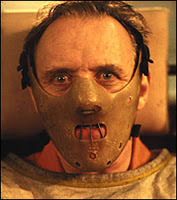 Hannibal Lecter is a good case in point here. Thomas Harris created in Hannibal such a deadly adversary that even the most experienced detectives had no option but to converse with him either through shock-proof glass or with him strapped to a gurney and wearing a mouth-guard. That would certainly be an attractive idea for our interview, but I’d query if the killer would even talk to us under such circumstances.
Hannibal Lecter is a good case in point here. Thomas Harris created in Hannibal such a deadly adversary that even the most experienced detectives had no option but to converse with him either through shock-proof glass or with him strapped to a gurney and wearing a mouth-guard. That would certainly be an attractive idea for our interview, but I’d query if the killer would even talk to us under such circumstances. I’d be surprised if any hardcore criminal, even one who hasn’t committed murder, would be prepared to talk to us about anything unless he or she was getting something in return. Consider that, and then bear in mind that the average incarcerated serial killer is almost certainly facing a full life tariff (and maybe even the death penalty) – and you can see how tough it’s going to be.
At the very least we’d have to be nice to them. So … no straps, no gurney.
And where exactly does that leave us? A rubber room, where there is nothing nasty the killer can put his/her hands on? Maybe, but the killer can still put his/her hands on us …
Might they be prepared to talk to us on the phone over a long distance?
Well, in that case we’re back to the old chestnut: it depends how much info we want. I remember hearing about a US journalist who regularly spoke on the phone to a serial killer serving life, asking his assistance in other unsolved murder cases. At first, the journo got the impression the killer was being helpful. But then he realised that the guy was playing games, imparting some information but on the whole offering just enough to make his correspondent come back for more. In other words, these phone-chats made pleasant breaks for the killer from his otherwise mundane life inside, and he wanted as many of them as possible.
After this, there aren’t too many options open to us.
Ultimately, I suppose, this is a question I can’t answer.
In a novel I’ve got planned for the future, Serial Crimes Unit officer, DS Heckenburg interviews an imprisoned serial killer in a quest for information, but in that one I’m opting for the gentler approach (it all takes place in a ‘soft interview room’, with comfy furniture and pictures on the walls). This female felon is showing contrition, you see, and so she’s deemed by her jailers to be lower risk. But she still wants something in return … and she wants it so badly that Heck has made a judgement call that she won’t try anything stupid.
Will she or won’t she?
At this stage, who knows.
I’m suppose I’m just glad this terrible business is something I write about rather than something I actually do.
*
THRILLERS, CHILLERS, SHOCKERS AND KILLERS …
An ongoing series of reviews of dark fiction (crime, thriller and horror novels) – both old and new – that I have recently read and enjoyed. I’ll endeavour to keep the SPOILERS to a minimum; there will certainly be no given-away denouements or exposed twists-in-the-tail, but by the definition of the word ‘review’, I’m going to be talking about these books in more than just thumbnail detail, extolling the aspects that I particularly enjoyed … so I guess if you’d rather not know anything at all about these pieces of work in advance of reading them yourself, then these particular posts will not be your thing.
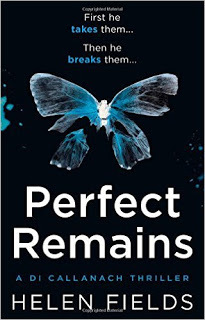 PERFECT REMAINS
PERFECT REMAINS
by Helen Fields (2017)
When ex-Parisian police detective and Interpol agent, Luc Callanach, transfers to Police Scotland, taking up a detective inspector post with the Major Investigations Team in Edinburgh, he isn’t completely a fish out of water. To begin with, Callanach is half-Scottish as well as half-French. He’s also a real bloodhound of a cop, with great analytical skills and a fearless dedication to the cases he is assigned – though on first arriving, it wouldn’t be true to say that he’s completely comfortable with his new environment.
After his sun-drenched days in the Interpol office at Lyon, he finds the Scottish capital windy, wet and dour, and quickly learns that certain officers at his command – the truculent DS Lively in particular – are irritated by his presence because they perceive him to be an outsider who’s been fast-tracked into a plum job.
Moreover, Callanach doesn’t help himself, because rather than attempting to win friends and influence people, he fights back domineeringly against those who seek to undermine him.
The reason for this is simple. Even without his sudden change-of-world, Luc Callanach is a man under astonishingly intense pressure. Back home, he was accused of raping a petulant beauty called Astrid Borde, whose main objection to Callanach was that he showed no interest in her. He wasn’t even charged, never mind convicted – but of course this meant that neither was he able to clear his name, so he left France under such a cloud of suspicion that even his family have now disassociated themselves from him.
He is a good cop who focusses intensely on his job, but even now he agonises over whether he could have handled things better, and as such he is filled with self-doubt, and to a degree, self-loathing.
Ironically, because he needs to be distracted from all this, it’s the perfect time for him to be handed a particularly difficult investigation – on his very first day no less, when what appears to be the burned remnants of an eminent Edinburgh solicitor are found on a Cairngorm hillside. There isn’t much left of the unfortunate woman, but it’s sufficient to reveal who she was and that she died very violently. Callanach throws himself into the case speedily and professionally, but then another prominent local woman – a vicar, no less – is also kidnapped, her tell-tale relics duly found in a drum of chemicals in a dockside warehouse.
Callanach is a by-the-book man. He doesn’t want to look at potential patterns just yet, but it seems increasingly likely that a serial abductor and murderer is at large, his sights fixed squarely on the successful women of the city. Callanach’s methodical approach then faces a serious challenge from within, when DS Lively – badly affected by the second abduction because he knew the victim personally – takes it on himself to call in renowned profiler Edwin Harris, an expert for sure, but a man more interested in promoting his own theories than in catching the actual killer.
Callanach’s protest that this is a breach of protocol falls on deaf ears, because head of the Major Investigations Team, DCI George Begbie, though sympathetic, is currently cash-strapped and has no option but to accept Harris’s assistance as it is being privately funded.
All of this hampers Callanach massively, both in terms of the enquiry and in terms of his personal recovery. Though he doesn’t feel quite so isolated when his friendship grows with fellow DI, Ava Turner, who, though she is currently investigating a different case, is very open – not just to cross-enquiry consultation, but also to afterhours socialising.
Meanwhile, in a parallel thread – and it’s no spoiler to mention this because we are hit hard with this intelligence very early in the novel – a certain Reginald King is hatching a truly heinous scheme. King, a sociopathic loner who work as a lowly admin officer in the Department of Philosophy at Edinburgh University, considers that he’s been at the beck and call of Professor Natasha Forge, Head of School, for quite long enough. In short, King regards himself as a genius and feels that Forge only doesn’t recognise this because she’s a stuck-up bitch. In the long run, he’s going to punish her, but he’s also going to punish lots of other women too. Hence the kidnapping, the imprisonment, the terrible torture and of course the murders.
Problematically for Luc Callanach, Reginald King, despite his lowly status, is a genuinely clever man, whose plan does not just involve a series of revenge killings, but is much, much more wickedly ingenious and twisted than that, and in terms of cruelty, is almost off-the-scale.
There’s one other problem here too, not just for Callanach, but all those who work with him. It’s a coincidence but of course hugely advantageous to the murderer that Natasha Forge’s best friend happens to be DI Ava Turner, another strong, independent woman. So this isn’t going to be any ordinary murder investigation, which all members of the enquiry team can go home from in the evening and relax; as King steadily advances his gruesome grand-plan, things start to get very, very nasty indeed, but also very, very personal …
There are plenty of psycho-thrillers set in contemporary Scotland, and Edinburgh seems to suffer from more than its fair share of fictional serial killers. But Perfect Remains is a very different kind of novel from the norm. Perhaps its most outstanding features are how well constructed it is as a story and how well written as a piece of crime literature. I don’t mean to say that other books of this ilk are not well written, but this one is truly of an exceptional calibre.
As a former barrister, Helen Fields clearly knows her legalities and her procedures inside-out, and yet she weaves them all into this complex and lurid mystery with an effortless, non-fussy style, which informs as much as it entertains, creating a real feel of authenticity but never once cluttering the quick-fire plotline with extraneous detail. In addition to that, her quality descriptive work fully conveys both the time and the place, not to mention the people embroiled in the saga, again without sacrificing any of the novel’s pace. Take one particular scene, for example, when DI Callanach, while stressed out of his mind, finds himself in an amorous clinch with an incidental character called Penny. Penny is little more than a walk-on, and as such could easily be a stock character whom we never think about again, and yet in the space of a page and a half, Fields brings her vividly and sympathetically to life – you almost want to cry for her, she is so unfairly treated by our emotionally distraught hero.
And that was only a member of the supporting cast, so imagine how it is with the leads.
The first thing that strikes me about these more prominent characters is that they are, none of them, free of foibles.
It’s not unusual in crime fiction for our star detective to be damaged, but Luc Callanach takes this to a whole new level. We are told that he is a good-looking guy and at one time he even worked as a male model, and yet none of this info is used to win our favour. If anything, it paints a picture in the reader’s mind of a man who, perhaps back home in his beloved France – which he endlessly and pointlessly yearns for – was rather spoiled. On arrival in Scotland, his initially brusque and rather snippy attitude only adds to this. It’s also the case that what he’s actually on the run from – a rape accusation, for Heaven’s sake! – is the sort of thing that would blemish any police officer’s record for the rest of his career. And after all that, he doesn’t help himself much – at least from the reader’s POV – with a constant, dogged self-analysis which borders on self-obsessiveness. But again, what we’ve got here is a realistically flawed character who needs to work very hard to win his audience over – and, as you might expect, he eventually does so. Firstly, because he’s willing to learn from his errors in order to correct his behaviour, particularly his people skills, and secondly because he’s an excellent detective who doesn’t miss a trick – it is Callanach’s instinct, and his instinct alone, that manage to refocus the enquiry after Lively and Harris send it barking down a blind alley.
In contrast, DI Ava Turner, though another stranger in a strange land (she’s Scottish, but an English-sounding accent born of a private education puts her at a disadvantage), is much savvier in her day-to-day management style, and in the way she handles suspects. She’s an equally tough cop to Callanach, but she’s never less than even-handed: for instance, when she zealously closes down an extremist Catholic sect for brutalising the underage mothers supposedly in their care, her comment to the press that there is “nothing godly about what was happening here” indicates that it isn’t organised religion she has a problem with, but those who abuse it.
Like Callanach, Turner is also single and, under the surface, maybe a little lonely, but she’s learned to ride with the blows and during her downtime is able to relax with friends – as such, she leads a happier, more fulfilled life. That said, her bosom buddy, Natasha Forge, is perhaps not quite so generous a spirit, and this provides us with a key link in the story.
Another confident, professional woman, Forge is pleasant and companionable if she decides she likes you, but terse to the point of being discourteous with office administrator, Reginald King, and okay, while King is without doubt a tad pompous and someone whose academic credentials are at the least dubious, there are times when we as the readers feel that his boss could perhaps be a little warmer towards him.
This of course leads me to King himself, and what I consider to be one of the most powerful pieces of characterisation in the whole novel. For me, Reginald King is so neatly observed and multi-layered an individual that he underpins the entire narrative, and on top of that he must rate as one of the most believable psychopaths I’ve ever encountered in fiction – primarily because, like so many real-life killers, his greatest defence is his total anonymity. King is no drooling Mr. Hyde-type madman, nor is he suave and calculating like Hannibal Lecter. Yes, he is secretly and monstrously narcissistic; he is convinced he is a genius and that the only reason he hasn’t advanced further in life is because those around him are hateful and jealous, and are conspiring in his downfall. But apart from this, he is so, so ordinary. He possesses neither Hyde’s brutish physicality nor Lecter’s sparkly-eyed gaze. He is a simple everyman you could pass in a corridor without batting an eyelid. Incredible though it may sound, there is even an element of pathos in King’s makeup. Because for all the awful things he does – and at times they are truly and torturously awful (and the reader is spared almost none of it) – there are other times when we recognise what a lost soul he is, a guy who, despite attempting civility, can’t even seem to earn the most basic degree of respect from his peers.
Helen Fields has done an all-round amazing job with Perfect Remains . It’s even more remarkable when you consider that it’s her debut novel. A terrific premise is executed to full unforgiving effect in a complex yet pacy procedural, which is peopled by living, breathing characters whom you can easily empathise with (both the heroes and the villains), and which is not only adult in tone but also adult in subtext – there is far more on show here than a simple crime/actioner – but which accelerates during its final quarter to an exhilarating, slam-bang climax.
In short, this is superb stuff – not a whodunit exactly, but an intense and deeply intriguing ‘good vs evil’ thriller, which once you’ve started it is quite impossible to put down. But don’t take my word for it. Just read it. You will not be disappointed – and make a note of the author too, because Helen Fields is a name we’ll be hearing about again and again.
And now, as always, here are my personal thoughts re. casting should Perfect Remains make it to celluloid. It’s just for laughs of course – no-one would listen to me anyway – but this could be a very cool cop series indeed, so it’s got to happen at some point. In the meantime, here are my picks for the leads (as always, with no expense spared):
DI Luc Callanach – Pio Marmai
DI Ava Turner – Gemma Whelan
Reginald King – Gray O’Brien
Natasha Forge – Ruth Millar
DCI George Begbie – Gary Lewis
Astrid Borde – Melanie Laurent
DS Lively – Tommy Flanagan
Edwin Harris – Graham McTavish
Published on February 08, 2017 02:09
January 25, 2017
When terror cuts through to our very souls
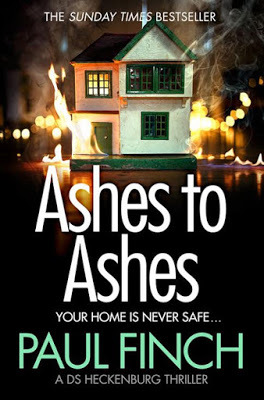 Uh-oh … it’s all getting personal this week, as we take a long, hard look at Scottish crime superstar James Oswald’s hit novel THE BOOK OF SOULS – because trust me, that is one investigation that takes his Edinburgh detective, Tony McLean, very close to home. But also, because we’re going to be talking about the cover to my new Heck novel, ASHES TO ASHES, which you can see right here – yep, this is the next cover, revealed in all its glory – and because we’re going to be discussing why this book will also be visiting a private Hell on its central character.
Uh-oh … it’s all getting personal this week, as we take a long, hard look at Scottish crime superstar James Oswald’s hit novel THE BOOK OF SOULS – because trust me, that is one investigation that takes his Edinburgh detective, Tony McLean, very close to home. But also, because we’re going to be talking about the cover to my new Heck novel, ASHES TO ASHES, which you can see right here – yep, this is the next cover, revealed in all its glory – and because we’re going to be discussing why this book will also be visiting a private Hell on its central character.
Okay, I’m not sure if any of that makes sense. Never mind, all we be explained soon.
In the meantime, if you’re only here for THE BOOK OF SOULS review, you’ll find that, as usual, at the lower end of today’s post. Feel free to skip on down there right away. If, however, you’re equally interested in Heck and keen to know more about the new book, then stick around at this end of the blog.
It’s always difficult when you’ve got a new novel due out, not knowing exactly how much you can and can’t say about it. You obviously don’t want to reveal too much, because that could spoil all kinds of surprises. But by the same token you want to whet as many appetites as possible.
It’s going to be particularly difficult on this occasion, because this unusual cover is likely to excite a bit of debate. And while I want to shove my own oar in, I don’t want to expose too much of the backroom discourse that has gone into the design of this latest novel of mine. That would feel an awful lot like giving away trade secrets.
It’s certainly the case that, in terms of the Heck novels, this cover is very different from everything that’s gone before it. And yet – and this is the really interesting thing – of all the Heck jackets to date, this is the one that I personally think cuts most quickly to the heart of the story (and not just the story, but what I suppose you’d call the subtext of the story).
And there we go – we’re already at a point where I can’t say too much more. You’ll just have to trust me that this cover is very, very relevant to the events in ASHES TO ASHES .
But, on this occasion I think there’s even a bit more to it than that. After all, an effective cover isn’t just about succinctly conveying the meaning of the book. It’s also got to be demography-aware; in other words, it’s got to recognise and respond to its core market. And markets, as we all know, can change on a regular basis.
What I mean is I’m sure that all we writers have our favourite book covers, and we all of us have clear ideas what we’d like to see on the fronts of our books. The problem is: we can’t always have what we want, especially if the marketeers tell us that a more effective alternative is available.
For example, I’ve made it fairly clear over the last few weeks with various Tweets and Facebook posts that one of the main antagonists in ASHES TO ASHES is a ruthless killer whose weapon of choice is a flamethrower. As such, my immediate thought about what I’d like to see on the jacket was something along those lines: a menacing figure in a visored helmet, wearing fireproof armour, perhaps driving a spear of flame right into our faces.
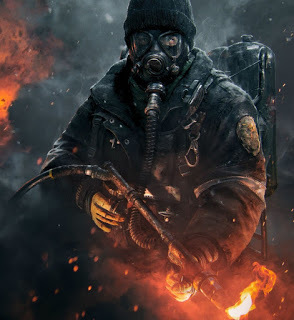 But you know, that wouldn’t have been massively original.
But you know, that wouldn’t have been massively original.Imagery of that sort has adorned games, comics and movie posters for decades (like this one on the right, from the third-person shooter game,
Tom Clancy’s The Division).
In addition, it tends to be associated more, I would suggest, with war-themed products, or something in the realms of a horror or sci-fi style Armageddon.
So when I heard that we weren’t going to use any such image on the cover of ASHES TO ASHES I was surprised, but only for a short time – before it occurred to me that it wouldn’t necessarily have made our target audience (the crime thriller crowd) looking twice.
And making you look twice is the key thing these days, especially when so many book covers are first seen online, usually as thumbnails (which also explains the big wording, and perhaps the less startling, less garish imagery than we used to see).
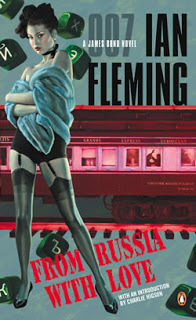 We’ve tried all sorts of tricks in the past to get potential audiences to spot our novels on the shelves: from racy pictures of gun-toting babes in heels and stockings, as inspired by 1960s spy thrillers; to more ghoulish subjects – corpses in sacks, dead hands with flies on them, rotted doll faces etc, as driven by the craze for ‘true crime’ books following on from Truman Capote’s seminal In Cold Blood; to the stark photographic images of masked killers, brutal weapons and captives-in-peril that represented the more realistically violent fashions of the 1990s and 2000s.
We’ve tried all sorts of tricks in the past to get potential audiences to spot our novels on the shelves: from racy pictures of gun-toting babes in heels and stockings, as inspired by 1960s spy thrillers; to more ghoulish subjects – corpses in sacks, dead hands with flies on them, rotted doll faces etc, as driven by the craze for ‘true crime’ books following on from Truman Capote’s seminal In Cold Blood; to the stark photographic images of masked killers, brutal weapons and captives-in-peril that represented the more realistically violent fashions of the 1990s and 2000s.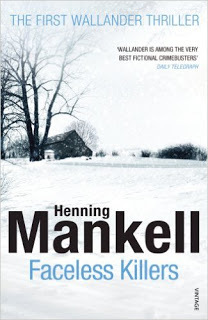 Even now, we see a wide variation dependent on the booksellers’ experience. Nordic Noir, for instance, often announces itself by portraying cold, desolate landscapes. British urban noir tends to focus on diminutive figures set against the immense backdrops of nighttime cities. Massive gangland sagas, or crime thrillers concerned with international intrigue often use subtle glamour – female beauty, jewelry, diamonds, casinos and the like.
Even now, we see a wide variation dependent on the booksellers’ experience. Nordic Noir, for instance, often announces itself by portraying cold, desolate landscapes. British urban noir tends to focus on diminutive figures set against the immense backdrops of nighttime cities. Massive gangland sagas, or crime thrillers concerned with international intrigue often use subtle glamour – female beauty, jewelry, diamonds, casinos and the like.So where does all that leave the cover for ASHES TO ASHES ?
Good question. Heck’s been around a bit for sure. He too has done the diminutive figure and the captive-in-fear thing. But this new cover is quite clearly something else. Very different, as we’ve already said. Eye-catching – I certainly hope so. And maybe – just maybe – a tad domestic in tone?
Domestic?, you ask.
Well, I’ve already said that I can’t reveal too many details about this new novel. But as I’ve also said, it’s a particularly personal story where DS Mark ‘Heck’ Heckenburg is concerned, and it cuts very, very close to home.
THRILLERS, CHILLERS, SHOCKERS AND KILLERS …
An ongoing series of reviews of dark fiction (crime, thriller and horror novels) – both old and new – that I have recently read and enjoyed. I’ll endeavour to keep the SPOILERS to a minimum; there will certainly be no given-away denouements or exposed twists-in-the-tail, but by the definition of the word ‘review’, I’m going to be talking about these books in more than just thumbnail detail, extolling the aspects that I particularly enjoyed … so I guess if you’d rather not know anything at all about these pieces of work in advance of reading them yourself, then these particular posts will not be your thing.
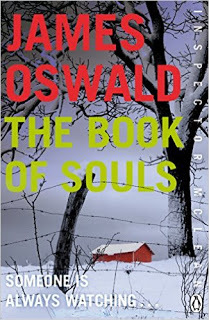 THE BOOK OF SOULS
THE BOOK OF SOULS by James Oswald (2012)
There can be few officers in the Lothian and Borders Police (as they were before ‘Police Scotland’) who’ve had a harder time of it than DI Tony McLean. A veteran homicide investigator whose normal beat is the grimy backstreets of Edinburgh, he thinks he’s seen and done it all, but as this second investigation in the McLean canon opens, the likeable but lonely detective finds himself under intense emotional pressure.
First of all, it’s nearly Christmas, which means the anniversary of the murder of his fiancée, Kirsty Summers, who was the final victim of Donald Anderson, an antiquarian book-dealer by trade and ritual sex-slayer nicknamed ‘the Christmas Killer’ by hobby. Every year for ten years, one of Anderson’s victims – invariably a young female – after being bound and raped in the cellar of Anderson’s shop, was found with her throat cut in one or other of the city’s filthy waterways. Kirsty Summers was only the most recent, and the last girl to die before McLean, then a detective constable, finally put an end to Anderson’s reign of evil. Needless to say, with it now being Christmas again, all the bad memories come rushing back. It’s a minor consolation – of sorts, when McLean learns that Anderson himself has now died in prison, the victim of a brutal attack by a fellow inmate. He even attends the funeral in Aberdeen just to ensure that he’s saying goodbye to bad rubbish.
But then, almost as soon as McLean returns to Edinburgh, another series of murders commences, which is almost identical to the one before: young women abducted, indecently assaulted and deposited in the city’s culverts and streams with throats slashed from ear to ear. To confuse things even more, a couple of occasions follow when McLean thinks he spots the deceased murderer walking the streets of Edinburgh, though of course, despite strenuous efforts, he’s never actually able to lay hands on anyone who looks even vaguely similar.
Despite this, our bewildered hero finds that he has the full confidence of his senior supervisor, Chief Superintendent Jayne McIntyre, but on this occasion he finds resources restricted because the bullish but somewhat empty-headed DCI Charles Duguid, known to his colleagues simply as ‘Dagwood’, has commandeered almost everything as part of the major anti-drugs operation he is running in the city, and deeply resents that McLean is leading a rival investigation.
At the same time, an unknown arsonist has been setting buildings alight all over the place. Most of these are disused industrial units, but then the block of flats in which Tony McLean himself lives is also torched, and several residents die in the process. This, in its turn, reveals that drugs production activity was occurring in McLean’s own building, right under his nose in fact, which is a huge embarrassment for him and deeply frustrates Chief Superintendent McIntyre, who insists that he’s overly stressed and must now attend psychological counselling sessions. This puts McLean in the clutches of irritating police-shrink, Prof. Matthew Hilton, who’s hardly the DI’s favourite person given that he interviewed Donald Anderson on his arrest and later tried to persuade the court that Anderson’s bizarre excuse for his crimes – namely that he was driven to kill by the evil contained in an ancient book – surely proved that he was insane.
In the midst of this seething tension, the copycat killer’s victims pile up, which only adds fuel to the fire in that a local journalist, Joanne Dalgliesh – in her efforts to sell a sensational new book – begins to air suspicions that Donald Anderson, evidently a mentally ill man, was framed by the original investigation team and now has died unjustly.
There will clearly be no rest this festive season for McLean and regular sidekicks like DS ‘Grumpy Bob’ Laird and station archivist John ‘Needy’ Needham. McLean gets some welcome assistance from the attractive DS Kirsty Ritchie, who is drafted in from Grampian Police, but finds he has very little time to devote to the potential new woman in his life, Emma Baird, who works for the police as a crime scene technician, and who, in truth, McLean is not sure he is right for.
It certainly seems as if nothing is going right. Even the glitz of the Christmas season, which is always there in the background, feels far removed from the cold, sterile offices in which McLean and his team must work, or the gloomy, half-empty house of McLean’s lately-dead grandmother, where he now must dwell. To match this mood, the weather switches regularly between snow and rain, constantly and consciously defying the yuletide spirit, creating a near constant aura of winter desolation.
But no evil lasts forever when good guys are on the case. A break finally comes along – but it’s a curious one. McLean first meets elderly cleric, Father Noam Anton, when he arrives at the detective’s door with a bunch of carol singers. But then he receives a second visit on Christmas Day itself, when Anton tells Mclean that he knew Donald Anderson well – the guy was originally a member of his monastic group, the Order of St. Herman, who among other duties, were charged with keeping rare books. Anton claims that Anderson, a tortured individual, stole a number of valuable volumes, including the Liber animorum, or Book of Souls, which legend claims was dictated to a deranged medieval monk by the Devil himself. This, Anton says, became the eventual cause of Anderson’s murderous depravity.
McLean is frustrated by this story – he believes it yet more excuse-making for a sexually degenerate serial killer – especially as there is no trace of the book now. To his mind that probably means it never existed, though an alternative – if somewhat fanciful – explanation could be that the Book of Souls has found its way into someone else’s hands and is now exerting the same malign influence as before, thereby creating another ‘Christmas Killer’.
It’s difficult to say more about the synopsis of The Book of Souls without giving away enormous spoilers, because there are several humungous twists and turns still to come in this complex and alarming tale (including one truly colossal head-spinner right near the end), but suffice to say that, whether he likes it or not, Tony McLean – ever more determined to catch the latest killer, and at the same time prove that he got the right one before – finally opens to the possibility that the answer to this mystery may lie in the occult …
One of the most interesting aspects of the Tony McLean books, at least in my view, is their regular supernatural undertone. Even though these are good, strong police procedurals – and The Book of Souls is no exception to that – you never get the feeling you have strayed very far from ‘the other world’. This intrigues and enthuses me because it’s often been said that horror and crime as rival subgenres simply don’t match, that there can’t be any overlap between the two because the rationale behind both forms of fiction should almost always work to cancel the other out.
If that is your resolute view, then James Oswald is definitely the fly in your ointment, especially when it comes to The Book of Souls . However, at first glance, what we're dealing with here is undeniably a cop thriller.
DI McLean is a little bit of an archetype in that regard: a flawed, tired loner in the midst of a mean city, almost invariably faced by opponents whose depths of wickedness know no bounds. Despite this, he’s an attractive figure; instinctively good at his job and no-one’s fool, but affable with it, trusting of colleagues (at least, those he rates), and yet monstrously unfortunate. I don’t think I’ve ever encountered a fictional copper who suffers as much bad luck as Tony McLean does, but he’s very well written too, a weary Scottish everyman, which makes him a character you root for from page one.
So far so familiar, of course. This is solid cop novel territory, especially when McLean and his team get a hint that a copycat murderer is on the loose, leading them a non-too-merry dance from one corner of Edinburgh to the next, and these, it won’t surprise you to learn, are locations distinctly absent from the tourist trail: we’re talking derelict factories, rundown tenements and rubbish-strewn lots where sewer outlets swim with disgusting effluent.
But for all this, we’re aware from an early stage that there’s something curious going on here. McLean’s occasional sightings of the deceased Anderson are an eerie touch, but Oswald handles them most effectively, restricting them to brief glimpses in the thronging city streets. These weird events are so scant that it’s actually quite easy to feed them into Jayne McIntyre’s concerns about McLean’s fragile mental state. Even we, the readers, who are 100% on McLean’s side, might fleetingly wonder if it’s all been a bit too much for him, and if maybe these psychological counselling sessions are actually a good idea – but then of course we dismiss such concerns, because McLean is the hero while police shrink/profiler Matthew Hilton is a pillock of the first order.
So … does this mean that something genuinely strange is happening? Could it conceivably be that what McLean is seeing is Donald Anderson’s ghost? It’s an increasingly unnerving thought given what McLean knows about Anderson’s past: the esoteric bookshop he kept and the foul rituals that happened in its basement. Then add to this the emerging information about the so-called Book of Souls, a demonic tome, which according to Father Anton, does not just possess its owner like an evil spirit, but gradually drains his or her entire soul.
Separate all that stuff from the police procedural, and you are in pure horror story country. But the real strength of this novel is that Oswald doesn’t do that; he splices the two threads together neatly, creating a fast-moving, ultra-dark thriller, which in no way contradicts itself and thoroughly entertains from beginning to end.
Possibly not one to read on a bright, sunny day – I’ll admit that much – but no sooner will the spring and summer be here, than winter will be coming round again in due course, and if you like your crime fiction hard-edged, dark-toned, and you aren’t disaffected by the festive spook story tradition, this could well be one for you.
As always at the end of a review, I’m being cheeky enough to suggest the cast I would choose were this book ever to make it to film or TV. Obviously, as The Book of Souls is number two in the McLean series, it would only be right for the eponymous hero’s previous outing to hit the celluloid first, but this is the bit where we always suspend belief anyway (on that score, wait till you see who I’ve chosen!!!).
DI Tony McLean - Ewan McGregorEmma Baird - Rose LeslieDS Kirsty Ritchie - Georgia KingSgt. John ‘Needy’ Needham - David O’HaraFather Noam Anton - Peter MullanDS ‘Grumpy Bob’ Laird - Tony CurranDCI Charles Duguid - Peter CapaldiCh. Supt. Jayne McIntyre - Tilda SwintonDonald Anderson – Clive RussellJoanne Dalgliesh – Zoe Eeles
(Ah, yes … another of those wonderfully expensive cast-lists that only someone of my limitless resources can assemble).
Published on January 25, 2017 08:28
December 1, 2016
Admit it, you're all just dying for Christmas
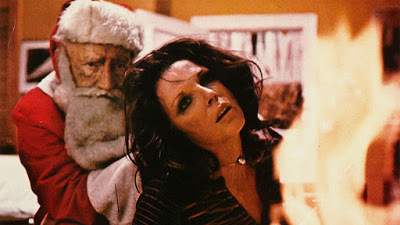
I don’t know about you, but whenever we get to December, I start thinking scary. I’m sure it’s as much to do with the short days, long dark nights and desolate, frozen landscapes as it is our midwinter tradition of telling ghost stories, though in truth, I don’t think any of us really need a reason. I now automatically associate the waning of the year, especially the days leading up to Christmas, with genuinely creepy tales – no nursery stuff about elves and pixies in this neck of the woods.
In that spirit, I’m this week reviewing an especially frightening horror novel, which also happens to be set in the depths of winter, in fact one of the darkest, coldest winters you could imagine: Michelle Paver’s thoroughly terrifying DARK MATTER. However, before we get to that - as usual, you’ll find a full review and discussion of that novel towards the lower end of this post - a word or two about my own ‘ghost story for Christmas’ output ...
Some of you may be aware that around this time each year, I’m in the habit of posting one of my own Christmas terror tales right here on this blog. There’ll be no exception to that rule this year, though as it’s not quite Christmas yet, you’ll need to tune in for a that a little later in the month. I've got no actual date for it yet, but it will be in a couple of weeks’ time and before December 24.
This year’s offering will be THE UNREAL, which features a ghost-hunter holding a solo vigil in a supposedly haunted theatre on a very cold and lonely Christmas Eve.
Before then, I’m going to make use of the time of year to unashamedly pimp some of my other Christmas stories - so apologies for this in advance. All have been published in the relatively recent past, but they may well have skipped your attention as they only tend to appear on readers’ radars between October and December.
The most obvious one that springs to mind is my novella of 2010, SPARROWHAWK , which has been reviewed in the following terms;
A supernatural feast in more ways than one.
The author superbly captures the atmosphere of 19th century London; the plot is gripping from the outset.
A Christmas tale with a twist that is captivating.

SPARROWHAWK is one of my favourite novellas, as it contains what I still consider to be some of my best writing. It follows the fortunes of Captain John Sparrowhawk, a veteran of the Afghan War of the early 1840s, who on surviving a campaign which saw all his men killed, returns home shell-shocked to find that his depressed wife has died during his absence. Resigning his commission and falling into drink and gambling, he soon runs up debts, which finally see him incarcerated in the terrible Fleet Prison.
This is where the story actually opens; with Sparrowhawk at his wits’ end after one whole year on Debtors’ Row, and no apparent way to purchase his liberty – until, very unexpectedly, and just as a bitterly cold December descends on London, the beautiful and enigmatic Miss Evangeline offers to pay his debts on the condition he will do a job for her: protect an unnamed middle class family against an unspecified foe for the duration of the Christmas period.
With nothing to lose, Sparrowhawk takes the job, but soon finds himself pitted against a very dangerous opponent – a supernatural entity with many and varied forms, which quickly takes advantage of the thick frost, freezing fog and heavy Yuletide snow, and wastes no time in using fragments of Sparrowhawk’s own tragic past to torture him.
Here’s a quick extract:
Sparrowhawk advanced a few yards into the park. As always, the moonlight reflected brilliantly from the snow, and at first he saw nothing. But then, gradually, he became aware of a heavy-set figure about thirty yards to the left of the bandstand. It stood perfectly still and watched him. He continued to advance, steadily. If this fellow was nothing more than a curious passer-by, the shotgun would involve some awkward explanations, but Sparrowhawk was playing for high stakes here, and he kept the weapon levelled.A few yards more, however, and he relaxed again.The figure was a snowman.Some children must have built it during the day, though when he circled it, it struck him as odder than usual. It had no features – no lumps of coal for eyes, no traditional carrot for a nose, yet someone had stuck a cigar where its mouth should be – a full-sized Cuban cheroot of the sort Sparrowhawk favoured but couldn’t afford. Likewise, the evening coat and top-hat, the former of which was velvet, the latter silk, made for expensive adornments. Even though the figure had no eyes, he felt as though it was looking straight at him. He contemplated knocking the thing down and trampling it, but decided that this would be cruel on the children who’d built it. At the very least he could take the cheroot, though it occurred to him that maybe the cheroot had been left here specifically for that purpose and that it might have been tainted in some way. On reflection, that seemed a little ridiculous, though of course stranger things had so far happened. Sparrowhawk resumed his patrol, ignoring the snowman further. The rest of his shift was uneventful, and in the morning he went back to his residence. When he returned the following evening, he noticed that the snowman had gone. He wandered around, but there was no trace of it. There wasn’t even a clump of messy snow where it had stood. The surface was smooth, unbroken – even though there hadn’t been another snow shower for the last couple of days.
SPARROWHAWK is a special case really, as on penning it, I didn’t set out with the sole intention of writing a horror story. If I say so myself, I think it’s a lot bigger than that, hence it’s length – at 40,000 words it’s a novella rather than a short. There ishorror in there – ghosts, monsters and festive frights – but I think it’s more a tale of self-discovery than anything else, with lots of romance as well, some Dickensian-era social drama, and lashings of the traditional Victorian Christmas.
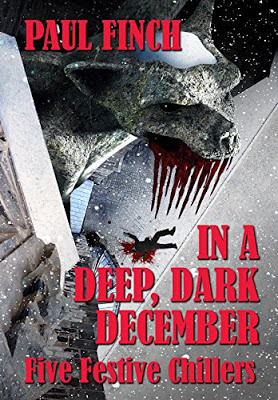 If you’re looking for some more typical seasonal terror, I’m still rather proud of
IN A DEEP, DARK DECEMBER
, which was first published in November 2014 (and republished this year in Germany, both electronically and in paperback, as
DAS GESPENST VON KILLINGLY HALL
) and which collects five of my Christmas horror stories. In this case, it’s exactly what it says on the tin: a bunch of seasonal chillers designed to make your hair stand on end. Here are some tasters and some short extracts:
If you’re looking for some more typical seasonal terror, I’m still rather proud of
IN A DEEP, DARK DECEMBER
, which was first published in November 2014 (and republished this year in Germany, both electronically and in paperback, as
DAS GESPENST VON KILLINGLY HALL
) and which collects five of my Christmas horror stories. In this case, it’s exactly what it says on the tin: a bunch of seasonal chillers designed to make your hair stand on end. Here are some tasters and some short extracts:THE CHRISTMAS TOYS
Two burglars target an ordinary suburban house one Christmas Eve, only to awaken the dark side of the festive spirit …
… it appeared to be an entire representation of Bethlehem in miniature. Fleetingly, Tookey was touched by long ago memories of his infant school days, when the hopes and fears of all the years had seemed to apply to him as much as all the other kids. The flat-roofed houses were brown or beige, as if moulded from mud-brick, the glow of mellow lamplight visible from each interior, donkeys and camels yoked outside. In the very centre, on a raised mound, there was a stable, its frontage removed, revealing a baby in a manger and toy soldier-sized figures of Mary and Joseph kneeling one to either side. Above them, a single star was suspended. Somewhere on the floor one of the wires to the fallen Christmas trees sparked, and the star began to shine with a pale, silvery luminescence. At the same time figures started moving in the town. Tookey watched in fascination as three or four men – again no more than toy soldier size – but distinctly sinister in hoods and cloaks, and with curved daggers, roved up and down the narrow streets, moving along electric runners which he hadn’t noticed previously. One by one they visited each house, the internal light to which would then turn blood-red – to the accompaniment of tinny shrieks.“What the …?” Tookey breathed. He had some vague memory of a school lesson during which he’d been told about that bad-tempered bastard – wasn’t his name ‘Herod’? – having all the babies killed to try and get to Jesus.
MIDNIGHT SERVICE
A stranded traveller in a desolate town one snowy Christmas Eve. Where can he find shelter? The former workhouse, of course …
… it was ludicrously dark. There didn’t seem to be any windows down there, not even small ones. On one hand this shouldn’t surprise him: he knew all about the old workhouses and how they’d been designed to be as uncomfortable as possible, to deter all but the most desperate poor; but on the other hand, if someone insisted on re-adapting one of those aged buildings for more modern use, was it asking too much that they update it a little? At the bottom of the stairs, he blundered into a damp, musty hanging – and only when he struggled past that did he at last see light: Christmas firelight shimmering around what looked like tall sections of flat, theatrical scenery. He shrugged his ram’s costume onto his shoulders as he sidled his way through. Somewhere ahead, he could hear whispers and titters of anticipation. It seemed the audience was in place.Then a woman stepped into his path.He recognised her as the woman he’d seen earlier. Her costume was rustic Victorian – that ground-length skirt, that shawl, that coal-scuttle bonnet from beneath which wisps of stringy, metal-gray hair protruded. But like Reverend What’s-His-Name, she was incredibly old, her face wizened as desiccated leather, her mouth a toothless, crumpled maw, her eyes milky, sightless orbs.
THE FAERIE
Timid husband Arthur snatches his young daughter and flees his angry wife across the wintry moors, finally seeking sanctuary in a mysterious snowbound house …
The house was now directly above them. Thanks to the flurrying flakes, much of it was still hidden, but his first guess looked to have been correct. It was about the size of an old barn, but its windows – in particular the two bay windows at the front – though mullioned, were almost certainly a recent installation. The mellow light that flooded out of them was extremely comforting.“Come on,” he said, unfastening his seatbelt and zipping his anorak up. He switched the engine off, and they climbed out of the car together. Initially the wind took their breath away; it had a sword’s edge, and a sword straight from the Pole. Snowflakes fluttered in their faces like moths as they fought their way up a tall flight of steps, which, thanks to each tread being several inches deep, were highly treacherous.At the top, they advanced along a short path – only visible as a linear and slightly sunken section of snow – until they saw the front door. It was impressively tall and wide, with a carved pediment over the lintel; it looked like a symbol of the sun with a tree growing against it. The door itself was of solid oak with a big brass knocker.
 “It’s a grand-looking place,” Arthur said. “Can’t think what it’s doing all the way out here in the wilds of Derbyshire.”He reached for the knocker, but the door creaked open as soon as he touched it.
“It’s a grand-looking place,” Arthur said. “Can’t think what it’s doing all the way out here in the wilds of Derbyshire.”He reached for the knocker, but the door creaked open as soon as he touched it.They glanced through, and saw an arched stone passage with low wooden beams across its ceiling. It ended at a flight of four broad steps, which led up into a living area. A rosy flush of firelight was visible up there, and a pleasant scent struck their nostrils, a combination of oranges and cinnamon, and something else – evergreens.
THE MUMMERS
Two men plot an elaborate Christmas Eve revenge by summoning a pantomime from Hell …
Phil glanced around at a gilt-framed portrait propped in a corner. It was done in dark oils and had been varnished in order to preserve it. Much of the varnish was now dirty and yellowed, but through it the deeply-troubled visage of Hugh Holker was still visible; an elderly man with sagging jowls, a heavily furrowed brow and thick grey tufts for sideburns. Phil had been in to look at the picture several times already, and still found it compelling. The artist had depicted Holker leaning forward on his fist, in a posture of dignified contemplation, but had etched despair and even fear into the final composition. The old industrialist’s eyes bore a stark quality, as if some ghastly apparition had just materialised before him. In the background meanwhile there were indistinct mist-forms, swirls and eddies of smoke or fog, which might have had more to do with the picture’s age than the artist’s intent, but which were ominously obscure all the same.“… to save us all from Satan’s power when we were gone astray,” sang Perry.With a pang of unease, Phil was reminded of his purpose here. He glanced at his watch – it read seven-thirty; time was ticking away quickly. Almost too quickly. He shivered – trepidation, anxiety, fear, all mixed in one; but then he heard again the raucous, gluttonous shouts filling the room behind him, and his nerves settled. What was it Eric had said? That this was an experiment? Yes, and Phil too was keen to see the result.
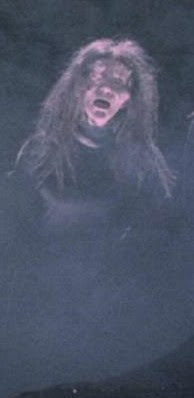 THE KILLING GROUND
THE KILLING GROUNDDuring an atmospheric English Christmas, man and wife security experts are hired to protect a film star’s family from the cannibal woman said to haunt their new country estate …
“Ruth, this is like the biggest load of crap in the history of humanity.” Alec zipped up his fleece jacket and stood shivering in the snow. It was ankle-deep, and flakes were falling steadily. They both stared up at the window to Claudette Duvalier’s bedroom. “Are you telling me someone couldn’t climb up there?” Ruth said.The window was some twenty feet up, but ten feet below it a kitchen-annex abutted outwards four yards or so. In keeping with the general architecture this too was castellated, but that wouldn’t present a major obstacle. To prove her point, Ruth clambered lithely up the drainpipe beside the kitchen window, scrambled over the mock-battlements, and then had only ten feet of sheer wall to scale. That might have been more difficult had it not been densely clad with ivy. She only had to ascend a few feet to prove it would easily hold someone of her weight. She jumped back down and stood next to her husband, beating fragments of leaf from her gloved hands.“Satisfied?”“No I’m not,” he said. “You’re wearing sweats and trainers. We’re talking about a woman in a long dress.”“Rags. Not exactly a long dress.”“Okay, you’re in peak physical condition. We’re talking about a woman who’s been dead nearly nine-hundred years.”
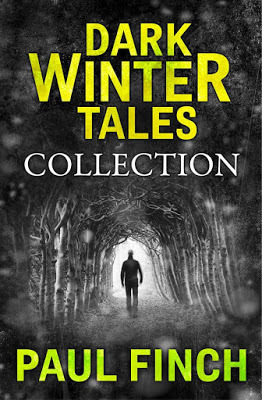 More recently, last Christmas in fact,
DARK WINTER TALES
was published. While this didn’t specifically include tales of horror associated with the Christmas season, it was published last December because my publishers at Avon (HarperCollins) were interested to see how well a collection of dark and spooky tales would sell at this time of year. There are only one or two supernatural stories in here, but all were selected (hopefully) because they are dark and suitably nightmarish in tone. Anyway, as above here are a few tasters and extracts:
More recently, last Christmas in fact,
DARK WINTER TALES
was published. While this didn’t specifically include tales of horror associated with the Christmas season, it was published last December because my publishers at Avon (HarperCollins) were interested to see how well a collection of dark and spooky tales would sell at this time of year. There are only one or two supernatural stories in here, but all were selected (hopefully) because they are dark and suitably nightmarish in tone. Anyway, as above here are a few tasters and extracts: THE INCIDENT AT NORTH SHORE
A policewoman is summoned by her secret lover to an illicit tryst in an abandoned theme park. Unfortunately, it’s the same night that a homicidal maniac has escaped from the nearby asylum.
Sharon stood by the barrier and phoned him again. Still it went to voice-mail. “Geoff!” she said under her breath. And then, because frankly she couldn’t take much more of this: “Geoff, where the hell are you?”A voice replied. At first she thought it was another echo, though on this occasion it sounded as if it had come from inside the Haunted Palace. She ducked under the barrier and stood at the foot of the access ramp, on which only eroded metal stubs remained of the rail-car system. The door at the top stood ajar. Finally, she ascended. It had definitely sounded as if the voice had called her by name. So it was Geoff. But if so, why didn’t he come out? She approached the door, the glare of her torch penetrating the gaunt passage beyond but revealing very little. When she entered, it stank of mildew. The ghostly murals that once adorned the fake brick walls had mouldered to the point where they were unrecognisable. She ventured on, turning a sharp corner – no doubt one of those hairpin bends where, for their own entertainment, everyone inside the car would be thrown violently to one side – and stopped in her tracks.A tall figure stood in the dimness, just beyond the reach of her torchlight.“Geoff?” she said, in the sort of querulous tone the general public would never associate with a police officer on duty.The figure remained motionless; made no reply.“Geoff?”Still no reply; no movement. She advanced a couple more steps, the light spearing ahead of her. And then a couple more, and finally, relieved, she strode forward boldly.It was a department store mannequin, albeit in a hideous state: burned, mutilated, covered with spray-paint. Up close, its face had been scarred and slashed frenziedly; for some reason, she imagined a pair of scissors …
CHILDREN DON’T PLAY HERE ANYMORE
A retired detective can’t give up on his last unsolved case. Who killed the young boy in the quiet stretch of woodland? A final clue reveals a horrible truth.
As I perambulate downhill, it strikes me as immensely sad how modern children are denied the youth of wild adventure that Geoff and others like him enjoyed. A wood like the one at the bottom of the Dell should not be silent and filled with undisturbed shadows; courting couples sneaking off into its undergrowth should not go unspied-upon; tadpole-filled ponds like the one deep in the middle here should not remain unplundered.But that is the way of it these days. And with good reason. The murder of Andrew Conroy was really quite horrible. More so from my point of view, perhaps, because I knew the kid personally. He was a contemporary of Geoff’s … went to the same school and scout troop, was a member of the same swimming club. Don’t ever believe it if someone tells you that police detectives get hardened to the slaughter of the innocents.Especially don’t believe it if those police detectives happen to work in their home town …
TOK
A series of strangulation murders are apparently committed by someone with non-human qualities. Bernadette suspects the weird stuffed creature in her in-laws’ gloomy old house.
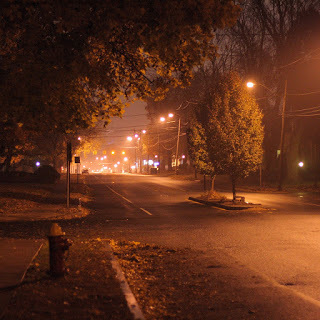 The Bannerwood wasn’t by any means a problem housing estate, being privately owned and suburban in character. But it was vast and sprawling, and on first being built it was occupied mainly by young families, which soon meant there were lots of children gambolling around – so many children, as Miriam Presswick would complain. Children in gangs, children running, children shouting, children screaming – and children encroaching, always encroaching, finding ever more reasons to trespass on her property: in summer chasing footballs or playing hide and seek among her trees, in autumn trick-or-treating or throwing fireworks onto her lawn. Berni didn’t know whether such persecutions had actually taken place or were purely imaginary, but given Miriam’s personal history it was no surprise that her sense of embattlement had finally become so acute that she’d had the outer wall erected, cutting herself off completely from the busy world that had suddenly encircled her. Despite that, but not atypically of psychological breakdown (not to mention advancing senility), even this security measure had in due course proved insufficient. In the last year alone, Miriam had contacted her son on average once a week to complain that people were trying to climb over the wall, were scratching on her doors, tapping on her windows. Nonsense, of course. Utter nonsense. Though Don had not admitted that. He would never have the guts to be so abrupt with his mother. He’d tried to calm her, tried to reassure her that she was imagining it – to no avail. And then, this last week, the murders had started.
The Bannerwood wasn’t by any means a problem housing estate, being privately owned and suburban in character. But it was vast and sprawling, and on first being built it was occupied mainly by young families, which soon meant there were lots of children gambolling around – so many children, as Miriam Presswick would complain. Children in gangs, children running, children shouting, children screaming – and children encroaching, always encroaching, finding ever more reasons to trespass on her property: in summer chasing footballs or playing hide and seek among her trees, in autumn trick-or-treating or throwing fireworks onto her lawn. Berni didn’t know whether such persecutions had actually taken place or were purely imaginary, but given Miriam’s personal history it was no surprise that her sense of embattlement had finally become so acute that she’d had the outer wall erected, cutting herself off completely from the busy world that had suddenly encircled her. Despite that, but not atypically of psychological breakdown (not to mention advancing senility), even this security measure had in due course proved insufficient. In the last year alone, Miriam had contacted her son on average once a week to complain that people were trying to climb over the wall, were scratching on her doors, tapping on her windows. Nonsense, of course. Utter nonsense. Though Don had not admitted that. He would never have the guts to be so abrupt with his mother. He’d tried to calm her, tried to reassure her that she was imagining it – to no avail. And then, this last week, the murders had started. GOD’S FIST
When a disgraced cop allows the violence of modern life to explode in his mind, an odd experience in a church confessional sends him on a mission to clean things up.
As a former cop, Skelton knew John Pizer of old; at least he knew about him. He knew for instance that Pizer – who’d begun his illustrious career offering protection to hotdog vendors outside football stadiums, but who then served time for GBH and later progressed as muscle for larger, wealthier outfits – now dabbled in smack, Ecstasy and illegal steroids, and ran sections of the red-light district, providing outlets where the hardest of hardcore porn was available, and controlling the dozens of goodtime girls who waited in the salons and parlours, or if they were drabber, skinnier and more visibly damaged by the life, in the roach-ridden alleys and backstreets where only the most desperate punters would seek them out. Pizer had now attained that relatively secure underworld status where he continued to reap the rewards but rarely got his own hands dirty, instead having numerous fall guys, or in his case girls, to take the rap. “Hey, John!”Pizer halted. It was just after eight, and he was taking his normal morning walk with his young pit-bull, Ivan. He was dressed in a snazzy designer running suit and flash trainers, but, as always, was distinctive with his gold-encased hands and his pink, shaven dome. Even so, he hadn’t expected to meet anyone he knew. He was cutting through a narrow ginnel to the park when he heard the voice. He turned – a tall, heavily built man, wearing jeans and a denim jacket, with a shock of black hair and dense black sideburns, was approaching.“Who are you?” Pizer asked. Beside him, Ivan started to growl.Skelton smiled. “Got a message for you.”“Yeah?”“From God.”Pizer looked puzzled. “Uh?”Skelton jerked his right arm forward, the monkey wrench shooting out from his denim sleeve, landing neatly in his right palm. “But this white-trash ornament gets it first.” He smashed the heavy tool down on the pit-bull’s head …
 WHAT’S BEHIND YOU?
WHAT’S BEHIND YOU?Art students think it’ll be a hoot to walk one-by-one through the supposedly haunted rectory. But it’s unnerving to be told that whatever they hear behind them, they must never look round.
“There have been shipwrecks on that coast throughout history,” he said in his melodious Welsh voice. “And it’s entirely possible the injured and dying were brought ashore at Rhossili Bay and perhaps spent their final minutes in Rhossili Rectory, a remote structure at the foot of Rhossili Down, and at one time the only habitation in the vicinity. There were also stories that this Rectory was built on the site of a Dark Age monastery, sacked by the Danes and later buried in sand during a tempest.” I remember that he watched us all closely as he spoke, smiling like a cat. He had a thick, red/grey brush of a beard and moustache, and round spectacles. His eyes, which were very green, twinkled like jewels beneath the rim of his fedora.“However,” he added ominously, “none of these potentially dramatic events can really explain the true depths of fear and despair this unholy presence has caused. You see, gentlemen … you must never turn and look. That is what they say.” We exchanged baffled glances, and he chuckled in that hearty way of his. “Rhossili Rectory is now ruined and empty, and according to the story, an evil spirit haunts it. One can only surmise that it may be connected to the historical events I have mentioned. But whatever its origins, the locals don’t take this as a joke. You’ll notice that when we arrive. The Rectory is far along the beach from Rhossili village and the boarding house where we’ll be staying. It’s very isolated – people do not go there.” “What form does this spirit take?” Flickwood asked, sounding nervous.“Oh, Mr. Flickwood … you walk through that ruined building on your own, day or night, and you will find out. I guarantee it.”
THOSE THEY LEFT BEHIND
The mother of the last man in England hanged becomes obsessed with the plastic head she sees on the market. When she learns it was part of a hangman’s dummy, she knows she has to have it.
Out of professional necessity, Shirley had already researched the events surrounding Tommy Dawkins’s execution. He’d been found guilty of murdering a girl called Mary Stillwell, who’d lived next door. Apparently he’d also mutilated her, quite horribly. No-one had really understood why he’d done it. Had there been something going on between them? Had Mary Stillwell resisted a sexual advance maybe? No answers were ever provided. But this had happened in 1965, and the twenty-year-old was subsequently tried, and, as he’d already confessed, was convicted and sentenced to death; a sentence carried out swiftly – only a few days before the passing of the Murder Act, which effectively abolished capital punishment in Great Britain. He’d been one of the very last men to hang. Whether this in itself was a sore point with Elsie, Shirley didn’t know. But it couldn’t have helped.Strangely, though the bereaved woman had proclaimed her son’s innocence at the time, and had tried to claim that his penalty was an injustice, she’d afterwards come to accept it with surprising speed and dignity. There’d been no histrionics in the following months, no letters to the newspapers or the Home Secretary. When, over the next few years, the policeman who’d arrested Tommy – Shirley thought he was called Mackeson – had occasionally come to visit Elsie, she’d maintained a cold but proud silence. Of course, Elsie was part of that steely World War II generation, who kept their grief and rage buried deep inside, only allowing it to surface now and then – like when her local church, previously a source of strength during her difficult years as a young widow, had refused even to acknowledge that there might be hope for her son in the afterlife.
 HAG FOLD
HAG FOLDWhen a run-down inner city district is terrorised by a sex-killer, a brutal firearms cop is brought in. He knows this area well. He grew up here. It left its mark on him as surely as it did the killer.
There’d already been numerous replacements at the top, senior investigators having been sacked, sidelined or forced through overwork into early retirement. A catalogue of errors, initially caused by a preponderance of evidence so vast it literally overwhelmed the pre-computer age intelligence system, had received glaring press attention and had been referred too scornfully in the House of Commons. We’d had the usual barrel-load of hoaxes, some obvious, some not so obvious, but all of which had had to be investigated, which had soaked up yet more time and manpower. Experts from Scotland Yard had been called in, but had failed to make an impact. Even the FBI had been contacted; they’d provided GMP detectives with a detailed profile of the killer, but that too had failed to get results. There’d been door-to-door questionings, traffic spot-checks, random stop-and-searches, follow-up interviews based on all vehicle registrations spotted in the district – still nothing. There’d even been widespread blooding for DNA, though that hadn’t been much use as the Strangler always took care to wear a condom when he raped. It’s probably fair to say that as much as was humanly possible was being done, but as long as the maniac was at liberty to strike, that wasn’t going to be enough. By the time I transferred to GMP, we had ‘Men Off The Streets’ marches to contend with, ‘Reinstate The Death Penalty’ protests, ‘public vigilance committees’ – basically gangs of drunken hooligans who got off on harassing strangers once the pubs had chucked-out, and a constant stream of well-meaning cranks, who poured into police stations armed with everything from crystal balls to divining rods. I avoided all this for as long as I could, putting in for one training course after another, sitting my sergeant’s exam, even volunteering to work Firearms at the airport. It might not sound very public-spirited of me, but let me tell you there is nothing even vaguely romantic about wandering the backstreets all night dressed as a tramp, or going house-to-house all day with an artist’s impression so vague it could be your own uncle and you wouldn’t recognise him. But after the Beverly Jones murder – she was the yummy mummy dragged from her own back garden – the shit really hit the fan. There was wholesale panic: police stations were besieged; patrol cars got jeered at; chief superintendents ran amok in their own offices ...
I hope all that was of interest. Sorry again ... there was quite a bit of self-pimpery there, but people often ask me these days what other books of mine can they read?, so I guess it’s only fair to post the details here. And as I say, at this time of year, it makes a kind of sense to focus those earlier publications that were specifically tailored for this dark and wintry time of year. Of course, as I mentioned at the top, it isn’t just me who prefers his horror to be a dish served ice-cold.
Now at last - I'm sure some of you must be thinking that - we reach that part of the programme where we talk about a different writer ...
THRILLERS, CHILLERS, SHOCKERS AND KILLERS ...
An ongoing series of reviews of dark fiction (crime, thriller and horror novels) – both old and new – that I have recently read and enjoyed. I’ll endeavour to keep the SPOILERS to a minimum; there will certainly be no given-away denouements or exposed twists-in-the-tail, but by the definition of the word ‘review’, I’m going to be talking about these books in more than just thumbnail detail, extolling the aspects that I particularly enjoyed … so I guess if you’d rather not know anything at all about these pieces of work in advance of reading them yourself, then these particular posts will not be your thing.
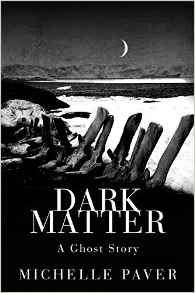 DARK MATTER
by Michelle Paver (2011)
DARK MATTER
by Michelle Paver (2011)
It is London in 1937, and young Jack Miller is something of a lost soul. He was raised in the middle-class, but now has no family or partner, he lives in a cheap, dreary apartment, and despite being a qualified physicist, his career prospects look bleak. He’s also quite clearly suffering from depression, though this isn’t the kind of thing you can talk about in these days of stiff-upper-lips, much less seek treatment for.
As such, Miller finds life a struggle. In fact, it’s damaged him. He’s become a misanthrope who doesn’t like or trust anybody, especially those he associates with the ruling class – which hardly helps when he volunteers to join a scientific expedition to the High Arctic, and in his first meeting with the organisers, finds them a well-heeled bunch, ex-public school boys who reek of old money.
Personality-wise, they aren’t an entirely bad lot. Expedition leader, Gus Balfour, is a traditional square-jawed hero, an Oxford Blue, a man’s man and all that – but he’s a genuinely friendly chap and is tackling the mission with an air of stolid professionalism. Algernon ‘Algie’ Carlisle is less attractive; pudgy, pompous and inclined to casual cruelty where animals are concerned. Miller initially despises Algie, but eventually weighs things up, and decides that anything must be better than lingering on alone in a bleak, fog-shrouded London, and so he grudgingly joins the trip, the destination of which is Gruhuken, on a remote stretch of the Spitsbergen coast.
When they arrive in Gruhuken the following autumn, it is a beautiful, pristine wilderness, but of course the intense cold here is likely to prove a real challenge, especially with the long darkness of the polar winter rapidly encroaching. Quickly and efficiently, the team set their equipment up, organise their cabin and then explore a little. There is nobody else here now, though there are signs that others have been present in the past: trappers, miners and the like. None of these appear to have lasted long, while hoary old Norwegian skipper, Erikkson, in charge of the team’s transport ship, doesn’t even like it that Gus Balfour’s team have turned up.
Erikkson won’t be specific about his fears, but strongly implies that something dwells on this coast which doesn’t like interlopers. And indeed, Jack Miller also starts to feel this, several times spotting what he thinks is an odd, distorted figure lurking in the vicinity of the camp. At first he is reluctant to let this trouble him, because for quite some time he is almost neurotically obsessed with how much he doesn’t like his expedition comrades, not even Gus Balfour – whom he has an increasing if (earlier on at least) unspoken attraction towards. Equally irrationally, he dislikes their pack of sled-dogs, even the youngest of the huskies, the frolicsome Isaak, who shows a clear disposition to be affectionate towards him.
However, Miller soon comes to learn the value of friends, as, one by one, through illness, injury and bereavement, they are forced to return home. The rapidly diminishing party feels increasingly marooned and ever more embattled by the worsening wintry elements: heavy snow, shrieking wind and deep sub-zero temperatures make for very cold comfort. When Gus Balfour collapses with an appendicitis, it looks as if the mission will end prematurely – because someone needs to escort the patient back to civilisation, which will leave only one person to man the base, and this just as the 24-hour ‘blackout’ of the Arctic Night is finally falling.
Defiantly, Miller – because even now feeling encumbered by his ‘ugly duckling’ status, he is keen to assert himself – volunteers for this task. It is only likely to be for a few weeks before the others return, but no-one thinks this is a good idea, especially not Erikkson. However, Miller insists, so in due course, he is left behind at Gruhuken, with the nearest human being two days’ sail away across the ice-clogged Barents Sea, and now facing the winter darkness entirely on his own.
Or so he would like to think. Because the stranded loner is very soon reminded that someone or something else is close at hand, watching his every move, growing steadily bolder as it senses his isolation.
Miller, a methodical sort who has many duties to attend, is bent on working his way through this ordeal by following a tight schedule that is designed to keep him busy. But slowly, his unease about the thing outside becomes full-blown fear, and eventually, with pitch-darkness covering the frozen land, terror. He now knows that he is not alone here. Something truly awful is prowling his perimeter; he hears it regularly, and glimpses it through the flurrying snow.
Can it enter the cabin? He prays to God not.
It’s possible that the dogs might dissuade this entity from drawing any closer, but then the dogs disappear too. Still, Miller holds on, expecting his companions to return imminently, only to receive another very grave shock: the sea is freezing over. Which means, not only that no boat can dock here and so the others may not be able to return to Gruhuken until spring, but that he can no longer leave even if he suddenly decides that he can’t stand it any longer.
Miller may be stuck here, facing this horror alone, for the entire duration of the Arctic winter …
One thing needs to be clearly understood from the outset with Dark Matter : this is a ghost story. That may be something you’d immediately infer from the teaser outline I’ve posted above, but you must to be under no illusion that this is what you’re dealing with. This is not a psychological thriller, or a tale of polar espionage, or a boy’s own mystery – this is an out-and-out ghost story very much in the tradition of M.R. James, and it’s a pretty terrifying one at that.
But that doesn’t mean to say this novel isn’t also multi-layered. There are all kinds of things going on here. To begin with, a number of different spectres haunt these eerie pages.
The spectre of World War Two is just around the corner; all the players on-stage are acutely aware of this, even if they rarely discuss it – their madcap mission is in some ways an attempt to run away from all that, because these young, able-bodied men are exactly the sort who, like their fathers before them, will be expected to enlist. Even the distant lands of the Arctic provide no real refuge from this sad reality, because, as we are we reminded several times, the mission itself has been underwritten by both the Admiralty and the War Office, who are looking to gather vital meteorological data.
In addition, we have the spectre of Miller’s latent and yet – at least as far as he’s concerned – unknown homosexuality. It informs his character throughout. He pathologically opposes almost everything the handsome Gus stands for, and so can’t understand his attraction to the guy. This in itself becomes an intangible form of torture for him.
And then of course there is the spectre of class division. Jack Miller doesn’t hail from the lowest stratum of society. He’s a middle-class boy, but he isn’t upper-class, and back in the 1930s – at least to young Miller’s immature mind – this is a big issue. After all, this is the age of the British Empire, an era when the rich weren’t idle, but saw it as their ancestral duty to go out and conquer the world, and if they couldn’t do that, go out and at the very least explore and civilise it. That is Gus Balfour all over, while Miller, in contrast, is part of the ‘nation of shopkeepers’, the everyday folk who, while not exactly poor, have no such hifalutin aspirations, and yet feel unmanned by this limitation of their lives to the eternally mundane.
Michelle Paver showcases this final spectre very neatly indeed, even to the point where it becomes irritating, we 21st century readers, who don’t experience this kind of thing, finally getting fed up with Miller and saying: “For God’s sake, Jack … these blokes are okay! Just do your job and man up!”
Man up, Jack!
Just what the author intends us to say, and exactly the kind of thing the posh boys of the 1930s would have said, had they used such parlance.
As well being a clever piece of work, Dark Matter is also exquisitely written. Michelle Paver, an Arctic traveller in her own right, paints a striking picture of the far, far north, which is all the more remarkable because she rarely references colour: everything up there is either white or grey, and yet the Arctic atmosphere is vividly communicated, as is its air of utter isolation. Early on in the book, this loneliness at the top of the world is exhilarating – we’re deep in the one of the last great wildernesses, a picturesque realm barely hinting at the existence of man. We can see it, feel it, smell it; it’s almost visceral – you literally shiver at the awesomeness of it.
But later on, of course, with the group decimated and the terrible threat of four months of complete and frozen darkness about to fall, everything changes. What was scenic becomes desolate, what was wild and untamed becomes life-threatening, what was merely unsettling becomes nerve-shredding.
Which brings me onto the ghostliness of Dark Matter ; the real ghostliness that is – the malevolent thing that actively haunts Gruhuken.
As I mentioned previously, we are in solid M.R. James territory here. Okay, we aren’t talking cathedral cloisters or misty graveyards, we’re in the High Arctic and there is only one person present, but this is every inch a Jamesian-style horror story.
The undead force menacing Jack Miller is real and deadly. It’s also relentless, and the atmosphere this creates, particularly in the later stages of the book, with Miller trapped in the claustrophobic confines of the cabin, struggling just to keep a single light burning, almost suffering a coronary at every undue sound (not an easy predicament with the polar wind screeching through chinks and snowflakes rattling the window-panes), is quite literally hair-raising.
But the author doesn’t just go full-bloodedly for this. From early in the text, she employs many crafty, low-key devices to disturb her readers: Isaak whimpering, his ears flattening whenever he senses evil approaching; a gruesome bear-hunting post seeming to move around of its own ability; Miller suffering a series of progressively more lurid and horrible nightmares.
Oddly, Michelle Paver has drawn some criticism for her use of these time-honoured methods. One or two critics aren’t impressed that Dark Matter is set in the ‘old world’, the actual time of M.R. James in fact, or that its basic concept is the isolation of an already stressed and nervous character in a terrible environment where the fear-factor will inevitably then crank itself up to an eventual crescendo from which only madness can result. There have been dark mutterings about Arthur Kipps in The Woman in Black or Eleanor Vance in The Haunting of Hill House , but as a reader who knew that he was acquiring a ghost story – because it said so on the cover – this is exactly what I wanted.
I have some sympathy with the more measured criticism that Dark Matter, though superbly written and intensely frightening, doesn’t do anything to progress the supernatural horror genre. But again, I suppose it all depends what you are reading it for. If you’re not looking for the cutting edge, and simply want to be terrified out of your wits by some good, old-fashioned scare-fare then this is undoubtedly a book for you.
Usually at the end of these reviews, I like to indulge in some fantasy casting, selecting the actors I myself would recruit if the narrative in question was ever to hit the screens (and this one would make a perfect ‘ghost story for Christmas’ of the sort the BBC used to do so well in the days before they became too sophisticated for all that). This is possibly the first in the series where we’ve not had to look for any ladies, but such is the nature of this particular beast. Anyway, here we go:
Jack Miller – Aiden TurnerGus Balfour – Tom BatemanAlgernon Carlisle – Tom HollanderErikkson – Vladimir Kulich
Published on December 01, 2016 01:08
November 16, 2016
Detective fiction: just how dark can it go?
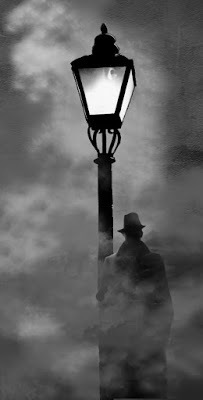 We’re deep in the darkness this week, focussing exclusively on the grimmer end of the crime fiction spectrum. In that vein, I’ll be reviewing David Pinner’s famous horror/thriller of the 1960s, RITUAL – which eventually hit the cinemas as THE WICKER MAN. In addition to that, I’m going to repost a blog I wrote for the A LOVER OF BOOKS website back in September, when they asked me the following intriguing question:
We’re deep in the darkness this week, focussing exclusively on the grimmer end of the crime fiction spectrum. In that vein, I’ll be reviewing David Pinner’s famous horror/thriller of the 1960s, RITUAL – which eventually hit the cinemas as THE WICKER MAN. In addition to that, I’m going to repost a blog I wrote for the A LOVER OF BOOKS website back in September, when they asked me the following intriguing question:HOW DARK CAN DETECTIVE FICTION GO?
Before we can answer this question, we need to remember that detective fiction is a pretty broad church, ranging from the pastoral-flavoured subgenre of the village green murder mystery to the ultra-violent world of inner city cops and the heinous criminals they pursue.
But by the nature of the beast, I think we must expect that it will always have the potential to get pretty dark. The bedrock of modern detective fiction for me is still the Hardboiled genre, as pioneered by the likes of Hammett and Chandler, and in which cynical antiheroes walk tightropes through worlds of crime and corruption.
Even back then in the more censorious 20s, 30s and 40s, our fictional investigators found themselves confronting the dregs of humanity, encountering contract killers, incest, rape, drug addiction, child abuse, sex slavery, domestic brutality – the whole gamut of social ills that still make us shudder when we’re watching the newsreels today.
It’s one of those difficult areas, I guess. In most cases, people read as a form of recreation, and therefore we authors write as a form of entertainment. But can it ever be morally acceptable to dredge through the most miserable of human experiences so that others can have fun?
The answer to that must be that we all live in the real world, and that we writers would be short-changing our readers if we tried to pretend that this wasn’t the case. It would be like telling a war story without the violence, or writing about the Third World as if there was no poverty or disease.
But the question still stands. How dark can you go?
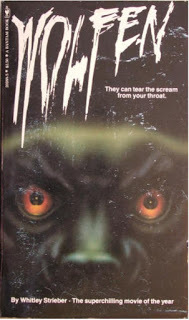 Well … I’ve seen it done superbly well at the extreme limits of the spectrum. If you look at the world of horror novels rather than thrillers, some amazing examples stand out:
THE WOLFEN
(1978) by Whitley Strieber, in which two New York detectives hunt for an apparent cannibal killer and gradually come to realise they are tracking a werewolf pack; and
LEGION
(1983) by William Peter Blatty, in which a time-served cop investigates a series of appalling torture murders in Georgetown, only to find that he’s dealing with Satanic ritual. Neither of these books stint on the horror, but such is the skill and intensity with which they are told, that they are basically unputdownable.
Well … I’ve seen it done superbly well at the extreme limits of the spectrum. If you look at the world of horror novels rather than thrillers, some amazing examples stand out:
THE WOLFEN
(1978) by Whitley Strieber, in which two New York detectives hunt for an apparent cannibal killer and gradually come to realise they are tracking a werewolf pack; and
LEGION
(1983) by William Peter Blatty, in which a time-served cop investigates a series of appalling torture murders in Georgetown, only to find that he’s dealing with Satanic ritual. Neither of these books stint on the horror, but such is the skill and intensity with which they are told, that they are basically unputdownable.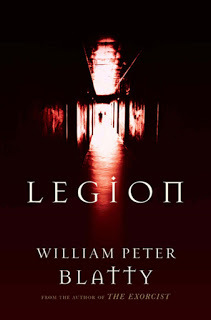 In these cases, of course, the supernatural element is likely to
In these cases, of course, the supernatural element is likely to alleviate any concerns one might have about excessive gruesomeness and depravity, because that earmarks these works as fantasy, which means that not only is it not real, but that it’s not supposed to be real.
We authors are on slightly dodgier ground when we are purporting to tell stories that could easily be true.
For example, when I sat down to write STALKERS , my first DS Heckenburg novel, in 2012, I wondered if the idea of the Nice Guys Club, a crime syndicate who for big money would provide clients with rape victims of their choice, belonged more in a horror novel than a crime thriller. It seemed a very extreme notion. However, at the time, and despite my prior police experience, I truly had no idea how much sex trafficking there is in the world, how much torture-for-fun, how many Snuf movies are made. It soon transpired that I had no need to worry about my risky concept, because it was only representing one harrowing aspect of real life.
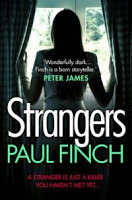 I think that’s why I’ve tackled my latest novel,
STRANGERS
– another potentially controversial one – in full-on fashion. This one is a no-holds-barred tale of the hunt by undercover policewomen for a female killer known to the press as Jill the Ripper, who preys on her johns and sexually mutilates them.
I think that’s why I’ve tackled my latest novel,
STRANGERS
– another potentially controversial one – in full-on fashion. This one is a no-holds-barred tale of the hunt by undercover policewomen for a female killer known to the press as Jill the Ripper, who preys on her johns and sexually mutilates them.We’ve all seen TV dramas in which female detectives go under cover as prostitutes, and it’s often treated lightly, as if all the heroine needs to do is don a short skirt and stand sexily on the nearest street-corner. However, I’ve seen enough of it in real life to know that this is far more difficult and dangerous work than that. And after extensive discussions with fellow author and good friend of mine, ASH CAMERON , who as a long-serving policewoman in the Met, performed this duty many times, I felt I had a duty to paint as realistic a picture as possible of this grim business.
So … I make no apologies for the grimy subways or dingy toilet blocks, for the vomit in the gutters, the needles in the back-streets, the abuse the girls suffer from their punters, the violence from the pimps and dealers, the thrown excrement, and so forth.
Yes, I suspect STRANGERS is the darkest crime novel I’ve ever written, but no – because of the desperate state of some of our real lives – I don’t think I, or any other crime writer of my acquaintance, has even come close to pushing the boundaries towards unacceptability thus far.
You think crime writing’s gone dark? You ain’t seen nothing yet.
THRILLERS, CHILLERS, SHOCKERS AND KILLERS …
An ongoing series of reviews of dark fiction (crime, thriller and horror novels) – both old and new – that I have recently read and enjoyed. I’ll endeavour to keep the SPOILERS to a minimum; there will certainly be no given-away denouements or exposed twists-in-the-tail, but by the definition of the word ‘review’, I’m going to be talking about these books in more than just thumbnail detail, extolling the aspects that I particularly enjoyed … so I guess if you’d rather not know anything at all about these pieces of work in advance of reading them yourself, then these particular posts will not be your thing.
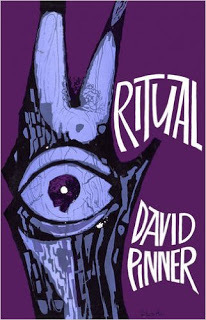 RITUAL by David Pinner (1967)
RITUAL by David Pinner (1967)In the late 1960s, the Cornish coastal village of Thorn is rocked when a young girl, Dian Spark, turns up dead at the foot of an ancient oak tree, apparently murdered in ritualistic fashion. But when idealistic young police detective, David Hanlin, is sent to investigate, he finds that he has entered a world apart.
It is a hot and beautiful summer and Thorn is a remote community, but this is not the picture-postcard Cornwall that we all know and love.
To begin with, the village itself is in a poor state, dull and impoverished, many of its buildings decayed, while the villagers themselves are odd and unfriendly. Mrs Spark, Dian’s bereaved mother, is a sultry but mysterious presence, courting a reputation for witchcraft and yet on the surface strongly opposed to the ancient rites that she is convinced caused the death of her youngest daughter. Her older daughter on the other hand, Anna – a seductive beauty and wannabe nymphomaniac – captivates Hanlin with her wanton ways, though, as he’s of a puritanical inclination, he also finds her revolting.
Other characters in the village are no less awkward to deal with for the out-of-place copper. Pastor White, the vicar, is patently mad. The penniless squire, Francis Fenn, plays bizarre flute music all day – badly, while out in the woods a homeless weirdo known only as Gypo provides a brawny and threatening presence. Meanwhile, at the rotten heart of the village sits retired local actor Lawrence Cready, an insufferably pompous and camp fellow, who occupies the manor house with his gay man-servant, Martin, and engages in strange and inappropriate games with Thorn’s resident tribe of rumbustious, urchin-like children.
We’ve already touched on Hanlin’s puritanical streak, and this soon becomes a key factor. Ever more certain that satanic practices are at play – especially as we draw closer to Midsummer Eve, for which some kind of secret celebration has clearly been planned – he throws his weight around with increasing anger and righteousness, ignoring the instructions of his superiors back in London, bullying some of the villagers and attempting unsuccessfully to make allies out of others. All the time he suspects that elaborate psychological games are being played with him, and yet, despite the occasional clues he finds and the air of decadence pervading the village (which also extends to the youngsters) he is unable to unearth any hard evidence.
When another child is murdered, Hanlin finally starts to realise that he’s out of his depth. His physical aversion to strong sunlight hampers him, the sensual Anna is a constant distraction – even he is becoming aware that his own bigotries are leading him to snap and fallacious judgements – and he feels increasingly tired and disoriented. The only remaining option, it seems, is to stick around for Midsummer Eve, to try and catch the malefactors in the act of their profanities …
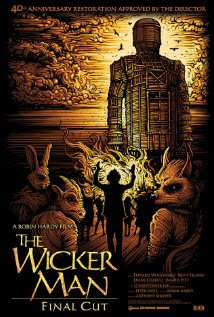 The first thing to say about this one-time infamous novel of the occult from celebrated actor and playwright David Pinner, is that it provided a kind of unofficial basis for
The Wicker Man
, which hit the cinemas six years later. It was not an easy translation from page to screen, however. Though Christopher Lee and Robin Hardy allegedly co-purchased the rites to
Ritual
in 1971, the story goes that they ultimately found it unfilmable and so screenwriter Anthony Shaffer created his own macabre tale based only very loosely on the original. Some vague similarities are present: the lone policeman investigating an isolated village drenched in esoteric lore; in the midst of it all a controlling and sophisticated man with entirely ignoble motives; and the tauntingly desirable landlord’s daughter, who in the most memorable moment in the book – one scene at least which made it to the film virtually unchanged – dances naked against her bedroom wall, driving her lonely male target on the other side almost crazy with lust.
The first thing to say about this one-time infamous novel of the occult from celebrated actor and playwright David Pinner, is that it provided a kind of unofficial basis for
The Wicker Man
, which hit the cinemas six years later. It was not an easy translation from page to screen, however. Though Christopher Lee and Robin Hardy allegedly co-purchased the rites to
Ritual
in 1971, the story goes that they ultimately found it unfilmable and so screenwriter Anthony Shaffer created his own macabre tale based only very loosely on the original. Some vague similarities are present: the lone policeman investigating an isolated village drenched in esoteric lore; in the midst of it all a controlling and sophisticated man with entirely ignoble motives; and the tauntingly desirable landlord’s daughter, who in the most memorable moment in the book – one scene at least which made it to the film virtually unchanged – dances naked against her bedroom wall, driving her lonely male target on the other side almost crazy with lust.However, there are also significant differences. The book does not end the way the movie ends, and though Hanlin is unhealthily obsessed with his own cleanliness and upright character, he gives little indication of devout religious belief. There is also more menace in the village of Thorn than we found on Summerisle; no one makes any effort to be reasonable with Hanlin, everyone he encounters demanding that he leave, while several of the oddballs who populate the place, rather than living comfortably in their strange, secluded world, are clearly on the verge of insanity.
But enough said about The Wicker Man . At the end of the day, that was a completely different animal, and now has legendary status its own right. In comparison, Ritual has largely been forgotten, but it is nevertheless a curious book and bit of a mixed bag.
Pinner’s poetic style and ornate language occasionally feels out-of-date in the 21stcentury. The ‘moral’ stance has worn badly too. While the corruption of youth through sensual pagan practises understandably horrifies Hanlin and is a precursor to our modern-age zero tolerance of child abuse, he also takes issue with Cready and Martin simply because they are homosexual, and at the same time, while massively turned on by village minx, Anna, he also wants to beat her for her wickedness – not much of a reconstructed man, then, David Hanlin.
There are other problems with the novel too. The portrayal of lackadaisical police procedures is pretty ludicrous, even by the standards of the rural 1960s. And I wasn’t entirely convinced by Hanlin’s methods of detection – there was a little too much instinct and not nearly enough deduction for my liking. But in truth none of this really matters. I was very glad to get hold of Ritual . It was a famous book at the time and has been long out of print, and once I dug into it, my various complaints notwithstanding, I still found it a compelling read.
There are genuine mysteries here, and a growing sense of fear as the clock ticks steadily down to the big event of the summer. But it’s also subtly done. With two children murdered, it would be difficult for anyone to argue there is nothing wrong with this place, but very little of it falls into Hanlin’s lap; there are times when even he wonders if he is imagining the witchery he relentlessly hunts. Hanlin himself makes an unusual hero – I wouldn’t say you empathise with him much, but he strikes an effectively forlorn figure as he battles the largely unseen forces of evil. I also rather liked Anna. The hooker with the heart of gold is something of a cliché in thriller fiction, but Anna is altogether deeper and more complex than that, and makes a mischievous and sympathetic foil to Hanlin’s humourless Cromwellian.
Overall, an intriguing and enjoyable read, recommended for those who enjoy a touch of blatantly old-fashioned occult horror (and aren’t too worried about a distinct absence of political correctness).
I usually like to end these book reviews with a bunch of actors I personally would cast if the tale in question ever made it to the screen. Well, I venture to suggest that the original Wicker Man is probably the closest that Ritual will ever get to that. But just for laughs – it’s always for laughs of course – here are my picks should Ritual (as oppose to TWM) ever get the full celluloid treatment:
DI David Hanlin – Kit HarringtonAnna Spark – Lily Collins Squire Francis Fenn – Freddie JonesLawrence Cready – Ian McKellenPastor White – John Hurt Mrs Spark – Minnie Driver
Published on November 16, 2016 08:21
November 3, 2016
Sad losses, big gains: life on the book trail
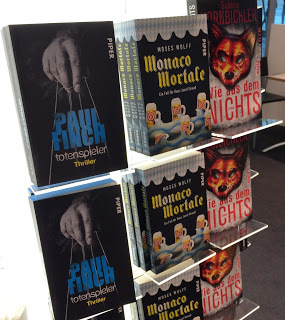 There is all sorts to talk about this week, some of it exciting, some of it rather sad. We’ll be discussing book festivals, both past and future, and also, because we’re back on the crime trail today, as oppose to the horror trail, where we were last week, I’ll be reviewing Don Winslow’s epic gangster saga, THE CARTEL, which I think I can safely say is one of the best crime novels I’ve ever read. If you’re keen to get to that book review quickly, you’ll find it, as usual, at the lower end of this blogpost.
There is all sorts to talk about this week, some of it exciting, some of it rather sad. We’ll be discussing book festivals, both past and future, and also, because we’re back on the crime trail today, as oppose to the horror trail, where we were last week, I’ll be reviewing Don Winslow’s epic gangster saga, THE CARTEL, which I think I can safely say is one of the best crime novels I’ve ever read. If you’re keen to get to that book review quickly, you’ll find it, as usual, at the lower end of this blogpost.A quick word first about the literary festivals – in a nutshell, I’m very flattered to have been invited as a guest to this year’s CHORLTON BOOK FESTIVAL , in Manchester, but I’ll also be chatting today about MORD AM HELLWEG VIII, in Germany, which I attended, also as a guest, last weekend; that was a truly remarkable experience.
However, before we get to all that, if you can spare me a minute and forgive a personal indulgence, I’d like to pay tribute to a friend and colleague who passed away quite recently after a difficult illness at the far-too-young age of 70.
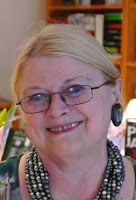 On October 25 this year, quite unexpectedly, we lost the lovely and astonishingly talented
CAROLE BLAKE
.
On October 25 this year, quite unexpectedly, we lost the lovely and astonishingly talented
CAROLE BLAKE
. As co-founder of the BLAKE FRIEDMANN LITERARY AGENCY in London, who have represented me for most of my professional writing life, and have been hugely involved in steering my professional career from its humble beginnings to the bestseller status I’m fortunate enough to enjoy today, Carole was a very significant person in my life, but she had a family too, and many, many close friends, not least her colleagues down at the Agency, who are all understandably devastated by this event.
A legend in the publishing industry, Carole achieved an awful lot in her life. She wasn’t just a powerhouse literary agent, representing such fine writers as Barbara Erskine, Peter James, Julian Stockwin and Anne de Courcy, she was a best-selling author in her own right, penning FROM PITCH TO PUBLICATION: EVERYTHING YOU NEED TO KNOW TO GET YOUR NOVEL PUBLISHED , which is regarded as a seminal work and is now in its 19th reprinting. She was also president of the Association of Authors’ Agents, second female chair of the Society of Bookmen, and chairman of BTBS, the Book Trade Charity, on whose board she served for 11 years.
An arch-professional and a huge personality, Carole’s loss will be felt for a very long time. I can only say that I am deeply honoured to have known her, and very lucky to have been within her sphere of influence.
*
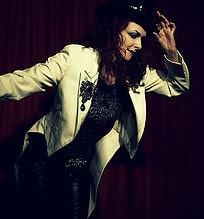 The annual
CHORLTON BOOK FESTIVAL
, a celebration of reading and writing – not just locally to Manchester, but from around the world – is a truly amazing event, which is now in its 12th year. Chorlton is famously regarded as ‘Manchester’s most literary suburb’, and many big-name authors have attended this festival since its inception. So I was massively flattered to get the call for 2016.
The annual
CHORLTON BOOK FESTIVAL
, a celebration of reading and writing – not just locally to Manchester, but from around the world – is a truly amazing event, which is now in its 12th year. Chorlton is famously regarded as ‘Manchester’s most literary suburb’, and many big-name authors have attended this festival since its inception. So I was massively flattered to get the call for 2016. The festival will take place at Chorlton Library between 18-26 November. It won’t just be about me, of course. Other authors due to attend – and this is quite a line-up, I’m sure you’ll agree – include mega-selling crime writer,
RACHEL ABBOTT
(pictured right), rising star and horror novelist
ANDREW MICHAEL HURLEY
, eclectic performer
ROSIE GARLAND
(pictured above) and poet
DAVID MORLEY
.
The festival will take place at Chorlton Library between 18-26 November. It won’t just be about me, of course. Other authors due to attend – and this is quite a line-up, I’m sure you’ll agree – include mega-selling crime writer,
RACHEL ABBOTT
(pictured right), rising star and horror novelist
ANDREW MICHAEL HURLEY
, eclectic performer
ROSIE GARLAND
(pictured above) and poet
DAVID MORLEY
.I myself will participate on Saturday November 19, from 7pm. Again this will be at Chorlton Library. I’m not exactly sure what form it will take – either a reading (from the next Heck novel perhaps?) and questions, or just a good old chinwag with both the moderator and the audience – but put it this way, I’ll be there for at least an hour and a half, more likely two (and there will be drinks as well). So if you fancy popping in, please do.
For full details of the week-long programme, check HERE .
Hoping to see some of you there.
*
And now for a literary festival that has already been and gone, but what an astonishing experience it was.
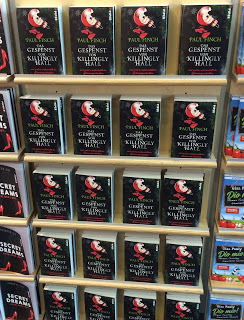 A few of you will probably know that my novels have been translated into German by the top German publishing house,
PIPER VERLAG
. Sales have been great, and I’ve periodically been the recipient of emailed photographs taken in bus shelters and railway stations in cities as far apart as Munich, Frankfurt and Berlin, which show my face adorning massive billboards. This is always a surreal experience because, admirer though I am of German culture, up until this year it’s a country I’d only ever visited once – fleetingly, during a backpacking holiday in 1984. As such, when I received an invitation from Piper to travel over there this autumn, and spend two nights in their company, attending two separate literary festivals, firstly Mord am Hellweg VIII in Hagen, and secondly the Piper Crime Night in Darmstadt, I was a little apprehensive.
A few of you will probably know that my novels have been translated into German by the top German publishing house,
PIPER VERLAG
. Sales have been great, and I’ve periodically been the recipient of emailed photographs taken in bus shelters and railway stations in cities as far apart as Munich, Frankfurt and Berlin, which show my face adorning massive billboards. This is always a surreal experience because, admirer though I am of German culture, up until this year it’s a country I’d only ever visited once – fleetingly, during a backpacking holiday in 1984. As such, when I received an invitation from Piper to travel over there this autumn, and spend two nights in their company, attending two separate literary festivals, firstly Mord am Hellweg VIII in Hagen, and secondly the Piper Crime Night in Darmstadt, I was a little apprehensive.Like so many complacent English folk, I’ve neglected a study of foreign languages – in short, I have no German whatsoever – plus, I didn’t know the country.
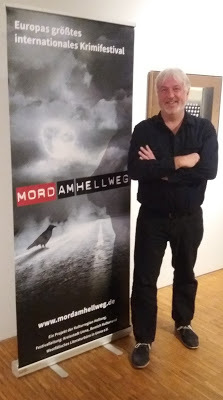 What I didn’t anticipate, though, was that when I finally got over there last weekend, none of this would prove to be any kind of obstacle at all – courtesy of my publishers.
What I didn’t anticipate, though, was that when I finally got over there last weekend, none of this would prove to be any kind of obstacle at all – courtesy of my publishers.Piper are a major force in German publishing, and produce some truly gorgeous books, mine included. On top of that, they treated me like royalty. Cathy, my wife, and I were chaperoned the entire time we were there, from our arrival at Frankfurt airport on the Saturday to our departure on the Monday, by Piper Publicity and Events Manager, Jana Remus, who didn’t just steer us through the complexities of the German railway and taxi systems, she also arranged and re-arranged bookings, and was always available to provide a translation if it was needed (though it rarely was, the Germans speaking English as well as they do).
I can’t express how grateful I am to Piper for taking care of all this. Every single potential cause of stress was removed from the trip, leaving nothing but a thoroughly enjoyable experience, which, unsurprisingly given that it was made in Germany, ran like clockwork.
The events themselves were as good as any I’ve ever been involved with.
 Mord am Hellweg, which is a huge celebration of modern crime-writing (apparently the biggest in Europe), had a real international feel from the outset. I was on stage the same evening as Swedish novelist and screenwriter
FREDRIK T. OLSSON
(left), Israeli crime writer
DROR MISHANI
(below), and Irish novel-writing team, Karen Gillece and Paul Perry, who work under the joint-name of
KAREN PERRY
(and what a very cool bunch of people all these folk turned out to be).
Mord am Hellweg, which is a huge celebration of modern crime-writing (apparently the biggest in Europe), had a real international feel from the outset. I was on stage the same evening as Swedish novelist and screenwriter
FREDRIK T. OLSSON
(left), Israeli crime writer
DROR MISHANI
(below), and Irish novel-writing team, Karen Gillece and Paul Perry, who work under the joint-name of
KAREN PERRY
(and what a very cool bunch of people all these folk turned out to be). There were literally hundreds in the audience, so many in fact that the organisers had to divide the punters at the Hagen Arts Centre into two different groups, one upstairs and one down (we then alternated between the two).
There were literally hundreds in the audience, so many in fact that the organisers had to divide the punters at the Hagen Arts Centre into two different groups, one upstairs and one down (we then alternated between the two). For my own part, I provided brief readings from HUNTED , recently published in Germany as TOTENSPIELER , which were translated by the very able and rather delightful journalist and moderator, Margarete von Schwarzkopf, again not that I think any translation was really needed - the German audience responded in positive and lively fashion while I was on the microphone.
To make it slightly easier for them, however, a second and much longer reading from HUNTED was then performed by FRITZ ECKENGA , a German actor, author and poet of considerable renown.
 This was pretty mesmerising. I reiterate that I don’t speak German, but Fritz (right) has the most amazingly rich and resonant voice, and he read the passage beautifully, making it sound magical. He later confided in me that he first determined to learn English after hearing Ken Branagh read some of Shakespeare’s sonnets, which he didn’t understand at the time but the sound of which completely entranced him. After being so enthralled by Fritz’s own musical delivery, I knew exactly what he meant.
This was pretty mesmerising. I reiterate that I don’t speak German, but Fritz (right) has the most amazingly rich and resonant voice, and he read the passage beautifully, making it sound magical. He later confided in me that he first determined to learn English after hearing Ken Branagh read some of Shakespeare’s sonnets, which he didn’t understand at the time but the sound of which completely entranced him. After being so enthralled by Fritz’s own musical delivery, I knew exactly what he meant.The second night was equally rewarding. This time, though it was officially the Piper Crime Night, we were guests of The Bookstore in Darmstadt, a large independent operation whose owner, Alfred Hofmann, regularly hosts literary events in his hometown. As before, it was hugely well-attended, and once again, when I read in English, I gauged very quickly from the audience that they understood near-enough every word. During the Q&A, translations were provided by local crime author and all-round top bloke, MICHAEL KIBLER , who made a very entertaining dinner guest afterwards.
 I was also honoured in Darmstadt to share the stage with
GISA KLONNE
(left), who is regarded as one of Germany’s leading crime-writers. Again, what a lovely lady and, afterwards, a fabulous raconteur.
I was also honoured in Darmstadt to share the stage with
GISA KLONNE
(left), who is regarded as one of Germany’s leading crime-writers. Again, what a lovely lady and, afterwards, a fabulous raconteur.One of the nicest things any author can experience, I think, is to attend a literary event and feel appreciated. That may sound like an obvious thing to say; it may even sound conceited, but when you’re invited to one of these things, and find only a handful of people there or detect an air of indifference when you’re making your address, it can be very dispiriting. That doesn’t happen often, but just happening once, it can be a huge blow to your morale. I must stress, by the way, that wanting a positive reaction at one of these festivals is not about some desire to be worshipped or idolised. It just means that you’re facing a bunch of people who have connected with your writing, and that’s really all you can ever hope for if you write to be published.
I felt this connection strongly last weekend in Germany. I spoke to so many people who were not just friendly and welcoming, but who were intimately familiar with my work; I must have signed dozens of books on both nights.
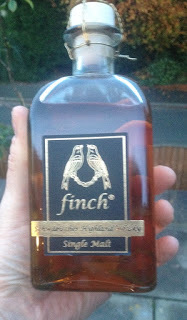 It’s easily the farthest I’ve ever travelled on a book-tour, and yet it is probably the most gratifying one I’ve done to date. I owe a huge debt of thanks to Jana and all the staff at Piper who made it possible, and of course to the organisers of Mord am Hellweg, who included Astrid Knoche and Antje Deistler as well as those I’ve already mentioned (please forgive me, guys, if any name has slipped my memory), and to Herr Hofmann and his wife for making us feel equally welcome at their event in Darmstadt (and for afterwards giving me an exceptional present, a bottle of locally-made malt whiskey, which – believed it or not – is named FINCH).
It’s easily the farthest I’ve ever travelled on a book-tour, and yet it is probably the most gratifying one I’ve done to date. I owe a huge debt of thanks to Jana and all the staff at Piper who made it possible, and of course to the organisers of Mord am Hellweg, who included Astrid Knoche and Antje Deistler as well as those I’ve already mentioned (please forgive me, guys, if any name has slipped my memory), and to Herr Hofmann and his wife for making us feel equally welcome at their event in Darmstadt (and for afterwards giving me an exceptional present, a bottle of locally-made malt whiskey, which – believed it or not – is named FINCH).The two images depicting racks of my books on sale in Germany, while taken in Frankfurt, do not come to us from last weekend, but were taken at the Frankfurt Book Fair earlier last month. Thanks to Helen Hurthwaite from Avon Books at HarperCollins, for sending these through to me.
THRILLERS, CHILLERS, SHOCKERS AND KILLERS …
An ongoing series of reviews of dark fiction (crime, thriller and horror novels) – both old and new – that I have recently read and enjoyed. I’ll endeavour to keep the SPOILERS to a minimum; there will certainly be no given-away denouements or exposed twists-in-the-tail, but by the definition of the word ‘review’, I’m going to be talking about these books in more than just thumbnail detail, extolling the aspects that I particularly enjoyed … so I guess if you’d rather not know anything at all about these pieces of work in advance of reading them yourself, then these particular posts will not be your thing.
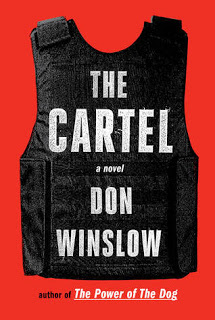 THE CARTEL by Don Winslow (2015)
THE CARTEL by Don Winslow (2015)In 2004, former DEA man Art Keller is a burnt-out wreck after decades of war with the Mexican drugs cartels. Having survived to middle age, and having lost his wife on the way and witnessed the torture and murder of his partner, he now lives in self-imposed exile, working as a bee-keeper at a remote monastery. His days of conflict are over. He’s had enough of the rest of the world.
But then disaster strikes.
His former enemy and leading drugs lord, Adan Barrera, after serving a short prison sentence that was more like a holiday, secures his freedom and commences where he left off with the aid of Magda, his intelligent ex-beauty queen wife, expanding and strengthening El Federacion, a huge but brittle alliance of Mexico’s most powerful and merciless dope gangs.
Keller knows his retirement is over.
Initially it’s a matter of being realistic. Barrera has put a huge bounty on Keller’s head. If the former agent doesn’t strike first, his life won’t be worth living. But the moment he gets back into the saddle, it all comes boiling to the surface: the hatred, the fury, the desire for revenge. Within no time, it’s as though Keller has never been out of the service – and the game is back on.
What follows is a ten-year cat and mouse game between two wily, determined individuals who detest each other. On paper, Barrera is far the stronger. He has El Federacion behind him, and a virtual army of gun-toting narcos and sicarios. Keller, by contrast, has a less-than-reliable network of nervous informers and untrustworthy US and Mexican bureaucrats. But Keller also has his skills and his wits, not to mention good contacts among rival syndicates. It isn’t difficult for him to create in-fighting and factionalism. Not that he needs to do this on his own. Because in response to Barrera’s return, the so-called Zetas have emerged under Heriberto Ochoa: a chillingly ruthless paramilitary mob which, while Barrera mainly peoples his organisation with gunmen drawn from the barrios and backstreets, is itself composed of former spec ops soldiers, who will wage a campaign of total annihilation to achieve their ends.
The resulting civil war in the Mexican underworld is almost too horrifying to believe, the Zetas in particular stopping at nothing to terrorise their opponents, not just shooting them, but decapitating, burning, dismembering and burying them alive – and on an industrial scale. Strings of the most incredibly heinous murders occur right in front of our eyes, the victims including men, women and children. While Keller watches, helpless, the appalling violence spreads all across Mexico, engulfing the ordinary population, wiping out entire districts, shocking the country to its core, paralysing it with fear.
Many events in The Cartel are based on real historical incidents, which in the mid-2000s transformed Mexico from a Spring Break paradise to a no-go war zone. But for the most part this is a fictionalised account. Most of the characters Keller encounters come from Winslow’s imagination, but they also serve a valid purpose. Among the villains, ‘Crazy’ Eddie Ruiz began life as the all-American boy, but got drawn into trafficking while still young, naïve and ambitious enough to think he could make it pay – and once in, of course, he found there was no way out. While Chuy, better known as ‘Jesus the Kid’, is a hollowed-out shell of a human being, a slum child so horribly abused that he makes the perfect killer for the crime bosses (and is a genuinely frightening presence, so coldly does he obey their monstrous orders). On the goodies’ side meanwhile, the journalist, Pablo – an everyday family man, who bravely reports on the horrors of the dope war, is representative of the many real life Mexican journalists who were murdered (131 of whom are referenced in the book in a sobering dedication list). Likewise, the moralistic Doctor Marisol Cisneros is much more here than Keller’s love-interest; she is the female face of Mexico’s innocent population, the wife/mother figure we’ve seen in so many conflicts of this type, who fearlessly expresses outrage at the atrocities and contempt for the madmen raping her homeland.
All of these heroes risk the most terrible reprisals, but ultimately, as Keller knows, the sad truth is that good people standing up for their right to live safe lives, will not be enough to win this war. His feud with Adan Barrera has become personal, and Keller is determined to take him down, no matter what it costs …
Where to start with The Cartel, except to say that it’s far more than a mere crime novel.
I mean, it is a crime novel. It’s probably one of the best crime novels I’ve ever read; an epic, awe-inspiring tale of one man’s non-stop war against a criminal organisation who, despite the colossal resources thrown at it, remains virtually unassailable, and how, in the process and because he’s already lost everything he values in life, he is brutalised beyond recognition, changing from a well-intentioned, justice-driven lawman into a remorseless, rule-breaking avenger.
But it’s also much, much more even than this.
Though it’s officially a sequel to Winslow’s previous gangster masterpiece, Power of the Dog , it won’t spoil your enjoyment to start here, because The Cartel is really the big brother of the two novels. It casts an enormous wide-angle lens on the entire tragedy that is Mexico in the era of the drugs wars, not just depicting the syndicates in all their gaudy, gory, soulless, nihilistic, wicked-beyond-belief glory, but also holding to account those government officials and business czars in both Mexico and the US who have kowtowed to them through fear or greed, and slamming the US in particular for a schizophrenic approach to hard drugs, which sees it on one hand spending billions of dollars to try and halt the flow of narcotics across the border, and on the other, through its everyday citizens, spending at least the same amount in efforts to acquire these substances and with no apparent awareness of the ghastly human cost.
Don’t for one minute assume the ‘Cartel’ the book’s title is referring to is El Federacion. Not a bit of it; in this novel, and clearly in the reality Don Winslow has so carefully and painstakingly researched, the blame for this ceaseless whirlwind of atrocities goes way, way further than that.
As such, it’s a true nightmare scenario, a gargantuan genocidal mess, which the author examines in unstinting and forensic detail. There is little-to-nothing that will uplift you in these 640 corpse-strewn, gunfire-riddled pages. It’s often heartbreakingly sad, and not just because of the endless massacres and executions of the innocent, harrowing stuff though these scenes are – one appalling and pointless slaughter of a bus-load of itinerant workers who have simply strayed into the wrong place is enough to freeze the blood – but it’s the whole calamity of a country once not just famous for its beautiful landscapes and wonderful climate, but also for its vibrant culture and artistry, its architecture and literary tradition, being utterly consumed by a crime-wave which explodes in all directions and without limit, by bloody wars that never end, and by what in truth amounts to wholesale, home-grown, fully militarised ultra-terrorism rather than traditional organised crime.
In the midst of this maelstrom, the ordinary Mexican people, and all the fictional characters who figurehead them, are dragged from pillar to post, battered, beaten and broken down, and yet everyman figures like Marisol the country doctor and Pablo the weary journalist remain defiant, exemplifying courage and common decency, doing everything they can to oppose the banditos and at the same time remain alive. Such is the skill of Winslow’s detailed and emotional story-telling that you get totally sucked in, becoming progressively more terrified for them (not to mention for everyone else – literally, no-one is safe in this book).
If you think this sounds like a glimpse of Hell, you’re basically right. However, there is some light to be had. Art Keller is the embittered focal point of the story, but he makes for an excellent central character. He’s not a young man. He’s tired and careworn, but he’s an expert in his field and a wheeler-dealer from way back, and his fatalistic obsession now is to spend whatever remains of his life hunting down Adan Barrera. This makes him a formidable foe for a crime syndicate who are not used to being nervous about anything, and each time he’s on the page you feel more than a pang of hope that, if anyone can pull this impossible task off, it’s Keller. But he’s a flawed hero for sure, using every trick in the book, both legal and otherwise: making and breaking alliances as it suits him; infiltrating the mob; undermining and double-crossing them; bribing the corruptible; turning former friends into enemies; indulging, if necessary, in the most murderous violence.
By comparison, his nemesis, Barrera, is not the demented monster you might expect. In fact, in contrast to the uber-vicious Ochoa, he’s remarkably restrained, running his world with a rod of iron, but a diplomat as well as a general, clever and ruthless but a suave fellow who values family life when he’s allowed to have it. He’s like the CEO of a large company rather than a gang boss, though again such is the skill with which he is drawn by Winslow, such are the subtle undercurrents of menace in Barrera’s urbane persona, that you’ve no doubt he’ll pull the trigger on anyone and everyone if the situation demands it.
Overall, The Cartel is more of an experience than a novel. For such a massive book, the pace rattles along – I read it in about three days – and that isn’t just down to the intensity of the shoot-outs or the horror of the murders and massacres; the complex judicial and political scene is also handled deftly, the labyrinthine dealings of all those involved in the dope game, even those not on the frontline of violence, are analysed from every angle, and yet it’s all done quickly and accessibly. There are literally dozens of characters, and yet every one remains vivid in the reader’s eye, proving easily and immediately recognisable.
The most negative comment I’ve read from any reviewer on the subject of The Cartel is that it’s ‘sprawling’. Well … it is. But that’s because it’s a genuine, bona fide epic. James Ellroy described it as “the ‘War and Peace’ of the dope wars”. I can’t argue with that. It’s grim, dark-hearted stuff, but at the same time it remains an amazing feat of crime/thriller literature.
At the end of these reviews, just for the fun of it, I usually name the cast I would pick if this book was ever to hit our screens. Apparently, a TV version of The Cartel has been in development for some time now, but I’ve seen nothing solid yet, so here, as always, are my picks for who should play the lead characters:
Art Keller – Leonardo DiCaprioAdan Barrera – Benicio del ToroMarisol – Sophia VergaraMagda – Eiza GonzalezPablo – Jesse Garcia‘Crazy’ Eddie Ruiz – James MarsdenHeriberto Ochoa – Joaquin Cosio
Published on November 03, 2016 02:47
October 23, 2016
My most blood-chilling moments in movies
 Well, it’s almost Halloween, and so we’re sticking firmly in horror mode today.
Well, it’s almost Halloween, and so we’re sticking firmly in horror mode today.
To start with, for this week’s book review, I’ll be discussing Peter James’s uber-scary haunted house chiller, THE HOUSE ON COLD HILL.
As usual with all my book reviews, you can find that at the lower end of this post.
 In the meantime, still in the world of spooks, my publishers at Avon Books (HarperCollins), who published my horror e-collection, DARK WINTER TALES, this time last year, have asked me this year if I’d ever consider putting together a list of my five scariest moments in horror films and offering a little synopsis in each case to try and capture the mood. As this is the kind of challenge I’m always up for, I undertook said task with relish, and here, today, are the results.
In the meantime, still in the world of spooks, my publishers at Avon Books (HarperCollins), who published my horror e-collection, DARK WINTER TALES, this time last year, have asked me this year if I’d ever consider putting together a list of my five scariest moments in horror films and offering a little synopsis in each case to try and capture the mood. As this is the kind of challenge I’m always up for, I undertook said task with relish, and here, today, are the results.I should reiterate that these aren’t necessarily what I consider to be the five best horror movies ever made, or even my five personal favourite horror movies; they are the five movies that happen to contain the individual scenes which I consider to be among the most spine-chilling or flesh-creeping, or both, ever put onto celluloid.
It’s a subjective thing, of course. I don’t expect everyone to agree with me, but I hope you’ll all at least agree that it’s a good bit of late-October fun.
So here we go, in no particular order …
IT FOLLOWS (2014)
After a disturbing sexual encounter with her mysterious new boyfriend, Hugh, Michigan college student, Jay, is relentlessly followed by a shape-shifting demonic entity, which only she can see. It pursues her at walking pace, but will not stop, never tires, and cannot be dissuaded in any way from continuing the pursuit. According to Hugh, when it finally catches up with her, it will brutally murder and mutilate her.
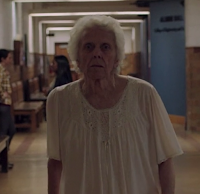 My favourite scene comes relatively early on in the movie, when Jay is still unsure that what Hugh has told her is true, but is sufficiently distressed by her last tryst with him to be concerned in class when she spies a curious figure approaching across the college campus: a gaunt old woman wearing what looks like a hospital gown, but apparently heading straight for her. Jay flees her lecture, only to be confronted by the same figure in the adjacent corridor, and up close it’s a ghastly specimen indeed. The chase is well and truly on.
My favourite scene comes relatively early on in the movie, when Jay is still unsure that what Hugh has told her is true, but is sufficiently distressed by her last tryst with him to be concerned in class when she spies a curious figure approaching across the college campus: a gaunt old woman wearing what looks like a hospital gown, but apparently heading straight for her. Jay flees her lecture, only to be confronted by the same figure in the adjacent corridor, and up close it’s a ghastly specimen indeed. The chase is well and truly on. LEGION: EXORCIST III (1990)
A veteran Georgetown police detective is baffled by a series of Satanic murders because they remind him of those committed by the Gemini Killer, who died in the electric chair several years earlier. He is also drawn to a chilling but unavoidable suspicion that there may be a connection between this series of slayings and the case of the possessed child, Regan McNeil, as dealt with in the original Exorcist movie, the events of which happened 15 years earlier.
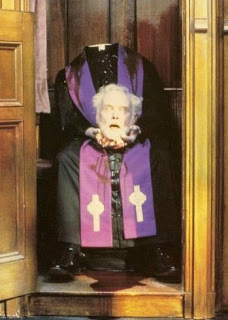 The most hair-raising scenein the film for me involves an elderly priest in the local Catholic church, who is hearing confessions. An unseen penitent enters the confessional. The priest can’t see who it is, of course, but at first all appears to be normal. The penitent speaks in an odd, creaky voice, but seems harmless enough, until suddenly, while cackling dementedly, he/she confesses to 17 sadistic murders. The priest is terror-stricken, but it’s too late. The scene ends with blood flowing out from under the confessional door.
The most hair-raising scenein the film for me involves an elderly priest in the local Catholic church, who is hearing confessions. An unseen penitent enters the confessional. The priest can’t see who it is, of course, but at first all appears to be normal. The penitent speaks in an odd, creaky voice, but seems harmless enough, until suddenly, while cackling dementedly, he/she confesses to 17 sadistic murders. The priest is terror-stricken, but it’s too late. The scene ends with blood flowing out from under the confessional door. SALEM’S LOT (2004)
A 21st century adaptation of the classic Stephen King novel, in which writer, Ben Mears, returns to his home town of Jerusalem’s Lot, in New England, where he intends to write a new novel that will help him shake off the demons of his past. Unfortunately, the town is ailing economically. Not only that, it is gradually being taken over by vampires from Europe, who are using the local residents’ own sins and weaknesses to attack them.
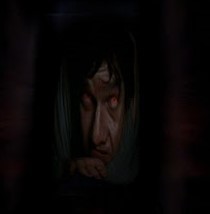 In discussing Salem’s Lot, either the 1979 version, or this one, most fans nominate the Danny Glick at the window scene as their moment of purest terror, but my scene occurs later on, when Mears and local man, Floyd Tibbits, fight and are jailed for the night in adjoining cells. Tibbits, part vampirised, forces himself along an impossibly narrow ventilation shaft to get at Mears, literally breaking and disjointing his own bones in the process. Mears manages to keep him back, and Tibbits is found dead the next day, having gnawed his own wrists and drunk his own blood.
In discussing Salem’s Lot, either the 1979 version, or this one, most fans nominate the Danny Glick at the window scene as their moment of purest terror, but my scene occurs later on, when Mears and local man, Floyd Tibbits, fight and are jailed for the night in adjoining cells. Tibbits, part vampirised, forces himself along an impossibly narrow ventilation shaft to get at Mears, literally breaking and disjointing his own bones in the process. Mears manages to keep him back, and Tibbits is found dead the next day, having gnawed his own wrists and drunk his own blood.NIGHT OF THE DEMON (1957)
Holden, an American criminal psychologist, arrives in England to investigate the activities of a so-called devil cult who are suspected of several murders. Holden isn’t buying that there is a supernatural angle to all this, but after he encounters Karswell, the urbane leader of the cult, who threatens him with demonic vengeance if he doesn’t call off the enquiry, a series of chilling events occur which gradually persuades him otherwise.
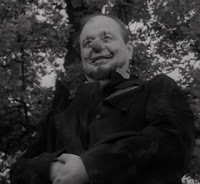 For me, the most memorable scenein this classic movie comes when Holden drives out to Karswell’s country estate, where a Halloween party is being held for children from the local village. Karswell, a self-proclaimed warlock, is as affable and charming as ever, and dresses as a friendly clown to entertain the youngsters, though once again he makes subtle threats to his adult guest. Holden maintains his air of amused indifference to this – until Karswell casually invokes a massive wind-storm, which destroys the party and sends the children screaming for cover.
For me, the most memorable scenein this classic movie comes when Holden drives out to Karswell’s country estate, where a Halloween party is being held for children from the local village. Karswell, a self-proclaimed warlock, is as affable and charming as ever, and dresses as a friendly clown to entertain the youngsters, though once again he makes subtle threats to his adult guest. Holden maintains his air of amused indifference to this – until Karswell casually invokes a massive wind-storm, which destroys the party and sends the children screaming for cover. JACOB’S LADDER (1990)
Wounded Vietnam veteran, Jake Singer, tries to rebuild his life in New York, but is increasingly plagued by bizarre dreams, flashbacks and chilling hallucinations, which slowly begin ripping his life apart. He seeks answers with other members of his old detachment, only to find that they are similarly tortured. Now, however, there are new dangers: a secret group is apparently hunting the vets down, while reality itself appears to be changing, much for the worse.
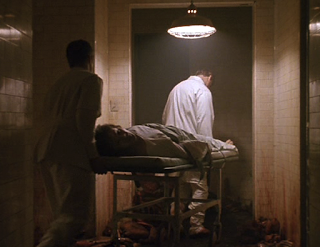 Easily my favourite scene in this twisting, turning head-trip of a thriller, and perhaps one of the most frightening scenes in any scary movie ever, occurs when Jake is abducted by unknown assailants and, after injuring himself while escaping a speeding car, is taken to a grimy hospital, and then transferred down to a lower section, which is a scene of utter horror, with corpses and body-parts strewing the filthy hallways, and raving mental patients caged or trapped in torture devices. Only now does Jake suspect that he might actually be dead and newly arrived in Hell.
Easily my favourite scene in this twisting, turning head-trip of a thriller, and perhaps one of the most frightening scenes in any scary movie ever, occurs when Jake is abducted by unknown assailants and, after injuring himself while escaping a speeding car, is taken to a grimy hospital, and then transferred down to a lower section, which is a scene of utter horror, with corpses and body-parts strewing the filthy hallways, and raving mental patients caged or trapped in torture devices. Only now does Jake suspect that he might actually be dead and newly arrived in Hell.THRILLERS, CHILLERS, SHOCKERS AND KILLERS …
An ongoing series of reviews of dark fiction (crime, thriller and horror novels) – both old and new – that I have recently read and enjoyed. I’ll endeavour to keep the SPOILERS to a minimum; there will certainly be no given-away denouements or exposed twists-in-the-tail, but by the definition of the word ‘review’, I’m going to be talking about these books in more than just thumbnail detail, extolling the aspects that I particularly enjoyed … so I guess if you’d rather not know anything at all about these pieces of work in advance of reading them yourself, then these particular posts will not be your thing.
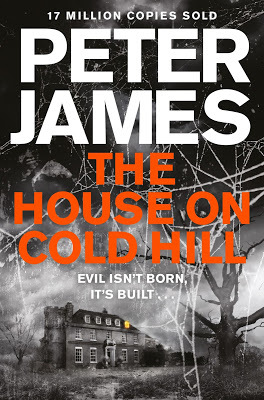 THE HOUSE ON COLD HILL by Peter James (2016)
THE HOUSE ON COLD HILL by Peter James (2016)When well-heeled Brighton couple and self-confessed townies, Ollie and Caro Harcourt, move out into the Sussex countryside, leaving their suburban life behind and taking possession of a rambling 18th century mansion, Cold Hill House, they are determined to make this new phase of their life work even though they expect it to be quite a challenge. Caro, a solicitor, is less than entranced by the place, finding it bleak and isolated, while Jade, their 12-year-old daughter, resents having been made to move away from her friends, but Ollie, a self-employed, home-based graphic designer who has always wanted to lead a rural lifestyle, sees it as a dream come true, and when push comes to shove, the whole family will admit that the grand old manor has great potential: it is a little run-down, a tad decrepit, but as long-term investments go it feels like a fairly safe bet.
But of course things are never quite so simple in the ever-menacing world of Peter James.
To start with, the house has many basic problems. There is a seemingly infinite list of structural defects, while time in general has taken its toll on the age-old property; the wear and tear is vastly more immense than the surveyors reported. Ollie, enthusiastic though he is, soon comes to fear that his new home may actually be a money pit.
Then there are those other, more intangible problems.
Within a very short time, the Harcourts start to suspect they are not alone here. Whose is the spectral female form they occasionally glimpse in the house? Who is the rather unpleasant old man Ollie several times encounters in the nearby country lane and yet whom no-one in the nearby village seems to know? Why is there a brooding atmosphere in this place when it should be so idyllic? And if all this isn’t bad enough, the fear stakes are upped dramatically when the family starts to have problems with their social media: strange figures appear on computer screens; bizarre and eerie messages are left via email, the origins of which are untraceable. Whatever the entity is that haunts this place – because it rapidly becomes clear that this is what they are dealing with here, a haunting – it is soon infesting their laptops, iPhones and other electrical devices.
These contacts are increasingly less pleasant, until eventually they become downright hostile, with progressively more callous and damaging acts accompanying them.
Whatever walks in Cold Hill House, it is not some dim and distant memory of a life lived long ago, it is a thinking, sentient being, and quite clearly it isn’t interested merely in distressing and alarming the Harcourts so much as in tormenting, torturing and ultimately destroying them …
I love haunted house books. The bar for me was first set with The Haunting of Hill House by Shirley Jackson back in 1959, and raised even higher – in terms of pure terror, if not literary merit – by Jay Anson’s The Amityville Horror in 1977. Both these books were particularly intriguing as haunted house stories went, because they presented us with nightmarish supernatural entities, mysterious, unknown beings hell-bent not just on scaring the innocents who had fallen into their clutches, but on terrorising them to death and beyond. As such, The House on Cold Hill was a real surprise for me, as I mainly know Peter James as a writer of superb crime thrillers. But this latest novel of his follows in the ‘Hill House’ tradition and adds comfortably to the canon.
All the author’s usual strengths are on display here. It is slickly and expertly written, which makes for a fast and easy read. The scene is set perfectly; you can picture the ornate but crumbling façade of the venerable old structure; you can smell the dank and stagnant air in its secret upper rooms; the rolling Sussex landscape is sumptuously present.
His characters, while not exactly oddballs, are not your regular heroes – they all have flaws (and very quickly and very cleverly the evil force seeks to gain leverage through these). Ollie Harcourt is the main protagonist, though he’s in some ways a rather effete and ineffectual figure – his initial response to the haunting is to try and shrug it off, in effect hoping that it goes away of its own volition. But it’s important to understand his plight. He has sunk every penny he’s got into this project; and when it suddenly seems like a bad idea, it’s too late for him to do anything – certain readers’ complaints that he should just have upped sticks and left simply don’t ring true. Likewise, he is dealing with something utterly beyond his ken. Ollie is your archetypical forty-something ‘Middle England’ guy. He’s never encountered anything horrific in his life, let alone anything paranormal. He is completely steeped in the contemporary world with its huge complexity of electronic gadgets and virtual superhighways – and when all this turns against him, in the most unconventional way, his scientific mind is unable to process it.
Which brings me onto another interesting aspect of the book: the science it employs.
Some reviewers have criticised The House on Cold Hill for not doing anything particularly new with the haunted house milieu. But the supernatural infestation of online media is something I’ve never seen done before, at least not this effectively. It goes even further than that. Despite the overarching supernatural atmosphere, science is never far away in this book. In fact, this is the first horror novel I’ve read in which the author seeks and explores a genuine scientific explanation for the existence of ghosts. And you know, it’s all pretty plausible. I’ll not give anything away, but Peter James has definitely done his homework. There is one scene in which Ollie Harcourt mulls over the situation with a physicist friend of his, and you can easily picture the author himself, a well-known and very thorough researcher, having exactly the same conversation with someone similarly qualified.
It’s also helps with the mood and authenticity that Peter James is personally experienced in this kind of scenario, as the lonely edifice at Cold Hill is apparently based on a real house he himself lived in once, and where he apparently had a less-than-comfortable time (though presumably he didn’t experience anything like the horrors on show here – I doubt he’d have emerged sane if he had).
All of this adds up to The House on Cold Hill being a very neat little ‘old school’ chiller. It’s no ground-breaker in horror terms, but it’s a good, absorbing read, which, being fairly low on gore – certainly compared to the Roy Grace books – is unlikely to make you scream with unbearable terror, but is guaranteed to creep you out repeatedly as you rustle through its traditionalist, doom-laden pages.
As usual – just for the fun of it – here are my picks for who should play the leads if The House on Cold Hill ever makes it to the movie or TV screen.
Ollie Harcourt – Rupert Penry-JonesCaro Harcourt – Anna Friel
Published on October 23, 2016 23:52
October 9, 2016
A tale of two Lucys - and both are shockers
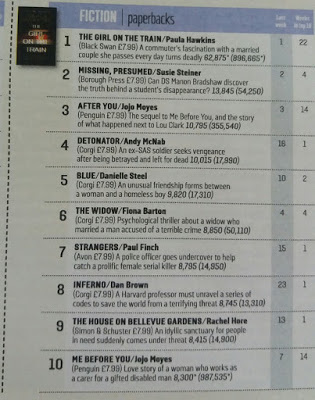 I’m offering a big thank you this week to everyone who’s bought my new girl-cop novel, STRANGERS, because thus far at least, in the 18 days since publication, it’s been a runaway success. We’re sticking with lady detectives in the review section this week as well, as I’ll also be talking about Nicola Upson’s rather marvellous THE DEATH OF LUCY KYTE, (though on this occasion it’s a very different kind of female investigator). As usual, if you’re impatient to get there, you’ll find a full review and discussion of that fine novel at the lower end of today’s column.
I’m offering a big thank you this week to everyone who’s bought my new girl-cop novel, STRANGERS, because thus far at least, in the 18 days since publication, it’s been a runaway success. We’re sticking with lady detectives in the review section this week as well, as I’ll also be talking about Nicola Upson’s rather marvellous THE DEATH OF LUCY KYTE, (though on this occasion it’s a very different kind of female investigator). As usual, if you’re impatient to get there, you’ll find a full review and discussion of that fine novel at the lower end of today’s column.In the meantime, thanks again to everyone who forked out to buy a copy of STRANGERS . We’ve had some rather spiffing reviews, and as you can probably see from the above image, sales have been so good that in the third week of publication, we made the Sunday Times Top Ten best-sellers list. It’s also been flying in the ebook charts, and is currently sitting somewhere just outside the top 20 (you can get it for only 99p on Kindle as part of the Amazon autumn promotion, though I think that deal runs out at the end of October).
STRANGERS has been an amazing journey for me thus far. I may have mentioned in previous blogposts that I originally evolved the character, Detective Constable Lucy Clayburn, way back in 1993 for a TV series that never was, and resurrected her only last year when my publishers, Avon Books (HarperCollins) asked me to interrupt my Heck series with a new police character, this time a woman.
 There’s quite a bit more back-story to it than that, of course, some of which I’ve recently given in more detail in several radio interviews. The first was with the lovely Becky Want (right) at BBC Radio Manchester (Lucy’s cases are all set in my native Greater Manchester). I don’t know how long they keep interviews on the BBC site, but if you act reasonably quickly, you can listen to it
HERE
(you'll find my bit at around 2.34pm-ish). The second was with the equally lovely Hannah Murray at The Book Show on Talk Radio Europe, which you can access HERE (from 7pm onwards).
There’s quite a bit more back-story to it than that, of course, some of which I’ve recently given in more detail in several radio interviews. The first was with the lovely Becky Want (right) at BBC Radio Manchester (Lucy’s cases are all set in my native Greater Manchester). I don’t know how long they keep interviews on the BBC site, but if you act reasonably quickly, you can listen to it
HERE
(you'll find my bit at around 2.34pm-ish). The second was with the equally lovely Hannah Murray at The Book Show on Talk Radio Europe, which you can access HERE (from 7pm onwards).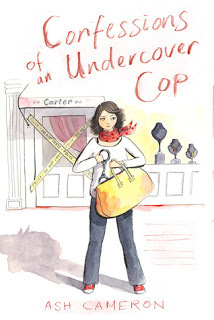 You may also be interested in a HarperCollins podcast I recently did with fellow author and ex-cop
ASH CAMERON
. One of the big challenges to writing
STRANGERS
came with having to relate the day-to-day experiences of a policewoman working undercover as a Manchester prostitute in order to catch a serial murderer of men. Even though I’m ex-job myself, this was a role I never played, though Ash did it on a number of occasions and several times was put through hell in her efforts to nail the bad guys.
You may also be interested in a HarperCollins podcast I recently did with fellow author and ex-cop
ASH CAMERON
. One of the big challenges to writing
STRANGERS
came with having to relate the day-to-day experiences of a policewoman working undercover as a Manchester prostitute in order to catch a serial murderer of men. Even though I’m ex-job myself, this was a role I never played, though Ash did it on a number of occasions and several times was put through hell in her efforts to nail the bad guys.If you tune in HERE , you can catch the podcast, which she and I did together and in which we discuss these experiences of hers and relate them to my new novel.
I was also very happy to make the Book of the Month in The Sun. I've posted that snippet just below.
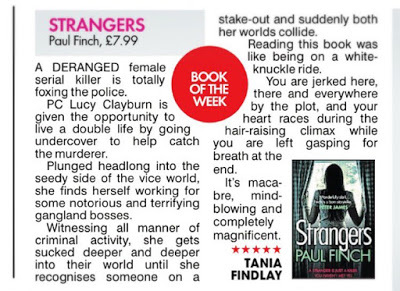
Sorry if all this seems like excessive self-pimpery, but I’m on Cloud 9 at the present with regard to the book and where it’s currently sitting. I promise I’ll start behaving in a more grown-up fashion as the year moves on and work commences on my next project, which at this moment in time may well – could be, who knows? – a horror novel / movie tie-in, though I genuinely can’t say any more about that at present. Let’s just see how things pan out.
(PS: If that latter disappoints you because you were hoping to hear about the next Heck, never fear. the manuscript for ASHES TO ASHES, formerly THE BURNING MAN, formerly RIGHTEOUS FIRE, has now been delivered to my publishers and we ought to be starting work on those edits very soon, with a view to seeing it on the shelves in March next year).
THRILLERS, CHILLERS, SHOCKERS AND KILLERS ...
An ongoing series of reviews of dark fiction (crime, thriller and horror novels) – both old and new – that I have recently read and enjoyed. I’ll endeavour to keep the SPOILERS to a minimum; there will certainly be no given-away denouements or exposed twists-in-the-tail, but by the definition of the word ‘review’, I’m going to be talking about these books in more than just thumbnail detail, extolling the aspects that I particularly enjoyed … so I guess if you’d rather not know anything at all about these pieces of work in advance of reading them yourself, then these particular posts will not be your thing.
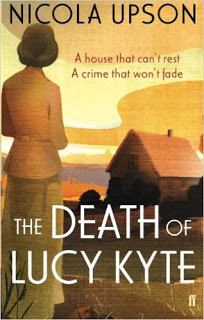 THE DEATH OF LUCY KYTE
THE DEATH OF LUCY KYTE by Nicola Upson (2013)
The year is 1936, the place Polestead in Suffolk, where successful Scottish writer, Josephine Tey, has inherited rundown Red Barn Cottage from her deceased godmother, Hester Larkspur, a one-time glamorous actress who, towards the end of her life, came to live as a recluse and was inexplicably shunned by most of her neighbours. One of the conditions in the will is that Josephine, who barely knew Hester, must take possession of the house herself, along with all it contains, but in concert with another benefactor, a certain Lucy Kyte, of whom there is no physical trace and whom no-one locally seems to know anything about.
However, this is only one of many mysteries that enshroud Josephine’s inheritance. The age-old cottage is crammed with curious artefacts, while one upper room in particular, which has a terrible atmosphere, is marked with disturbing and perplexing graffiti. An infamous atrocity, the Murder in the Red Barn – when, back in 1827, village beauty Maria Marten was butchered by her handsome lover, William Corder – occurred only a few dozen yards away, while an eerie ghost story connected to this crime still seems to haunt the village. Enquiries about Hester’s own death indicate that the elderly lady was hiding from someone or something when she expired from natural causes.
Seemingly, there has been much unpleasantness in and around this melancholy house, though no-one now will speak of it.
Isolated, and increasingly threatened by a nebulous but persistent presence, Josephine attempts to unravel the various puzzles, researching the details of the original crime and at the same time establishing the final movements of her godmother, whose death she is progressively more certain was hastened by foul play.
Josephine is a gentle person rather than a fighter. This makes her an unlikely hero, but she is intellectually superior to almost everyone she meets, and this gives her a big advantage, which is something she’s going to need – because even with the Red Barn a distant memory and Polestead now an idyllic summertime hamlet, there is a constant undercurrent of menace here. No one is really happy in this place. The hostility from certain neighbours is palpable, especially when Josephine starts asking questions, and even some of those who initially appear friendly possess an air of alarming superficiality.
Scratch this benign surface deep enough, it seems, and something very nasty may emerge from underneath …
My initial thought on The Death of Lucy Kyte was that it wouldn’t be for me. It had the overall aura of what used to, somewhat condescendingly, be referred to as a ‘woman’s book’. But very quickly I was seduced by Nicola Upson’s expert control of mood, not to mention her exquisite writing. The characters, both living and dead, are vividly drawn, their intricate and complex relationships deftly handled. Hester Larkspur in particular is a wonder. Given that she never appears in the book, we get astonishingly close to her through her property and diaries, and through Josephine’s fond ruminations on her melodramatic life in the Edwardian-era theatre.
But it is Josephine herself, for whom this is the fifth adventure to be novelised, who’s the real star of the show. Based on the Inverness-born mystery writer, Elizabeth Mackintosh, she is a very reserved person, almost to the point of being stuffy, primarily happy when in her own company or with Marta, her upper class lover, and yet easily frightened and affected emotionally by grief and solitude. And yet this apparent vulnerability is deceptive – Josephine has hidden depths of resilience, not least her absolute determination to get justice for Hester.
The investigation this leads to is fascinating.
To start with, there are actually two narratives interwoven here, both of them sprinkled with clues. The secondary thread, the tale of Maria Marten’s death and the execution of her killer by hanging and dissection, is enthralling, its gruesomeness and the general hardship of that age richly evoked by the author and contrasted sharply with the pastoral landscape of the Suffolk Weald in the 1930s. The ‘current’ narrative meanwhile, has an ambience all of its own, and lightens the dark mystery with some nice touches of gentle comedy, including guest appearances by none other than Tod Slaughter, the famous British star of Grand Guignol cinema, King Edward VIII and even Wallis Simpson.
I won’t go as far as to say that I was blown away by The Death of Lucy Kyte – there are times when it felt a little as if it was meandering, but despite its leisurely pace, it is increasingly fraught with danger and finally culminates in the unmasking of one of the most narcissistically nasty villains I’ve ever come across on the written page.
Overall, this is a high quality psychological/supernatural thriller, very much in the style of one of the slower-burn Hitchcocks. Maybe I’d have liked a slightly more conclusive pay-off, but ultimately it isn’t that kind of novel. Besides, the Josephine Tey story-arc is now five books in and counting, so lots of pay-offs, I suspect, are still easily possible.
As always – just for a laugh – here are my picks for who should play the leads if The Death of Lucy Kyte ever makes it to the movie or TV screen (though if it ever does, the series would have to start with An Expert in Murder, which is Josephine Tey #1):
Josephine Tey – Ruth ConnellJane Peck – Lindsay DuncanMaria Marten – Rosamund PikeWilliam Corder – Tom Weston-JonesLucy Kyte – Daisy RidleyMarta Fox – Kate WinsletTod Slaughter – Brad Dourif (Controversial choice? Naaah … I think he’d be exceptional)
Published on October 09, 2016 07:30
September 26, 2016
Lethal ladies who chill (and spill) the blood
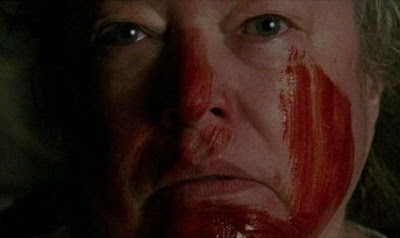
This week we’re perhaps even more in the realms of crazy killers than usual, though thankfully some of them (but only some of them) are imaginary. Example: I’ve recently read Graham Masterton’s remarkably graphic but enthralling crime novel, WHITE BONES, and offer my detailed review of it today – but as usual, at the lower end of this blogpost. First of all, in light of the recent publication of STRANGERS, I thought this might be an appropriate time to post an article I’ve recently penned focussing on maniacs of a more real world ilk … specifically, on this occasion, those of a feminine persuasion.
So … deadlier than the male? You decide.
My crime novels to date have followed the fortunes of Mark ‘Heck’ Heckenburg, a seasoned detective sergeant attached to the Serial Crimes Unit at Scotland Yard, and his pursuits of some truly heinous criminals: mass murderers and serial killers whose violent rampages have shocked the country to its foundations. Almost exclusively, these felons have been male, they have run up scores of victims, and their motives have been so twisted and bizarre that in many cases they’ve defied understanding. However, in my new novel, STRANGERS , we change the scenery a little.
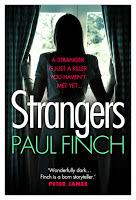 Lucy Clayburn is a brand new character; a feisty young female detective constable in the Greater Manchester Police – ambitious to do well, and eager to bring her own brand of justice to the streets. She’s inexperienced though, and doesn’t fully enjoy the confidence of her superiors. At the same time, somewhat unfortunately – or fortunately, depending on your view – she comes up against a particularly deadly opponent. ‘Jill the Ripper’ is a female serial killer, who seduces random male victims, and then purely for her own gratification, murders and mutilates them.
Lucy Clayburn is a brand new character; a feisty young female detective constable in the Greater Manchester Police – ambitious to do well, and eager to bring her own brand of justice to the streets. She’s inexperienced though, and doesn’t fully enjoy the confidence of her superiors. At the same time, somewhat unfortunately – or fortunately, depending on your view – she comes up against a particularly deadly opponent. ‘Jill the Ripper’ is a female serial killer, who seduces random male victims, and then purely for her own gratification, murders and mutilates them.So, in truth, you could say that STRANGERS doesn’t just change the scenery … it completely reverses it.
You see, it had occurred to me that so often in crime fiction the narrative reflects the usual tragedy of real life in that an opportunist male predator hunts down innocent females. But in opting with STRANGERS to turn this cliché on its head, I wasn’t just trying to be politically correct – I was looking to focus on one of those lesser-known but nonetheless very real creatures that inhabit some of the darkest corners of criminality: the female lust-slayer.
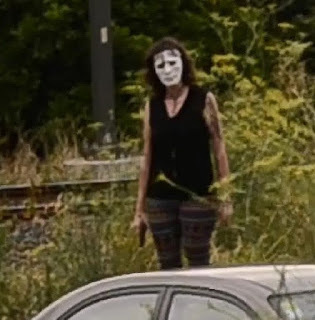 We’ve always known that women are just as capable of committing multiple murder as men, but on the whole – certainly in the popular imagination – mass murderesses have tended to fall into several distinct categories: ‘black widow’ types, who poison their loved ones or those they are caring for in order to gain financially; so-called ‘baby farmers’ (again, the perceived motive for this is usually financial); or as the submissive partners in murderous duos, who tend to act under the direction of more dominant males. One thing you tend not to see among women who repeatedly murder is the lone predator, a sadist who prowls for victims and kills purely for the fun of it.
We’ve always known that women are just as capable of committing multiple murder as men, but on the whole – certainly in the popular imagination – mass murderesses have tended to fall into several distinct categories: ‘black widow’ types, who poison their loved ones or those they are caring for in order to gain financially; so-called ‘baby farmers’ (again, the perceived motive for this is usually financial); or as the submissive partners in murderous duos, who tend to act under the direction of more dominant males. One thing you tend not to see among women who repeatedly murder is the lone predator, a sadist who prowls for victims and kills purely for the fun of it.At least, this was what I thought … until I commenced some simple, basic research. With remarkable speed, I began to accrue information which was completely contrary to this assumption. Female serial killers, it seems, can be just as brutal and cruel as any of their male counterparts, and their motives can be just as bizarre.
Here, in no particular order, are five of the most terrifying:
 JEANNE WEBER (the Ogress of Paris)Weber, a small but brutish woman, was similar to many other serial killers in that she enjoyed incredible good fortune during her murderous career. She was an efficient murderer, for sure, but not an intelligent one, regularly leaving clues behind and finding herself in compromising situations with regard to her child victims, and yet somehow she continued to evade capture until she’d accounted for at least ten innocent lives.
JEANNE WEBER (the Ogress of Paris)Weber, a small but brutish woman, was similar to many other serial killers in that she enjoyed incredible good fortune during her murderous career. She was an efficient murderer, for sure, but not an intelligent one, regularly leaving clues behind and finding herself in compromising situations with regard to her child victims, and yet somehow she continued to evade capture until she’d accounted for at least ten innocent lives.An alcoholic from an early age, uneducated and boorish, Weber first arrived in Paris in 1888, worked a succession of poorly-paid jobs and found herself living in a slum. She married in 1893, but her husband was also a drunk and any chance of a normal family life evaporated in 1905 when their two young children mysteriously died.
From this point on, children dying in close proximity to Jeanne Weber would become a regular occurrence. In March 1905, on two different occasions, she was babysitting for her sister-in-law, when fatalities occurred: her two nieces, 18-month-old Georgette and two-year-old Suzanne, were both found dead by their parents, but attendant physicians put the double-tragedy down to ‘convulsions’. When another of Weber’s nieces, seven-year-old Germaine, died later that month, again while her aunt was babysitting, it was written off as diphtheria (despite the clear marks of strangulation on his throat), as was the death of Weber’s own baby son, Marcel, four days later (on which occasion, yet again, the bruising on the victim’s throat was ignored).
Weber’s luck almost ran out the following month, when she was caught trying to throttle her ten-year-old nephew, Maurice. She was subsequently tried for eight murders of children, including her own, and those of Lucie Aleandre and Marceal Poyatos, who were not related to her but had also died while in her care – and yet thanks to the skilled defence work of lawyer Henri-Robert, Weber was acquitted. History repeated itself in 1907, when Henri-Robert successfully defended her for a second time, this time for the death in her charge of nine-year-old Auguste Bavouzet – on this occasion the famously erudite lawyer managed to convince the court the child had expired from typhoid.
Even when captured attempting to strangle another child while working as an orderly in a care home, Weber was merely sacked from her post rather than charged. And because the incident was hushed up rather than publicised, it left her at liberty to strike again – which she duly did in 1908, when she attacked the ten-year-old son of her landlord. This time the child’s father intervened, and apparently had to hit Weber three times in the face before he could break the grip she had on the child’s throat.
Tried again, this time for ten murders, Weber was certified insane on October 25 1908, and condemned to spend the rest of her days in a lunatic asylum. She lasted ten years before committing her last successful strangulation – this time on herself.
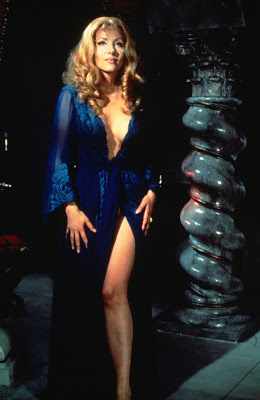 ELIZABETH BATHORY (Countess Dracula)Elizabeth Bathory is one of the most nightmarish figures in all criminal history, and is regularly likened to a female Vlad the Impaler. Her life story reads like the screenplay for a horror movie, and in fact she’s been the subject of several.
ELIZABETH BATHORY (Countess Dracula)Elizabeth Bathory is one of the most nightmarish figures in all criminal history, and is regularly likened to a female Vlad the Impaler. Her life story reads like the screenplay for a horror movie, and in fact she’s been the subject of several.Born into the Hungarian aristocracy in 1560, she initially had everything a woman could realistically hope for in the Middle Ages. Niece to Stephen Bathory, Prince of Transylvania, she led a wealthy, privileged lifestyle, was well-educated, beautiful and the heiress to vast estates. Her marriage to Ferenc Nadasdy, Commander in Chief of the Hungarian army, was attended by 4,500 guests. At the same time, as a wedding gift from her husband, Elizabeth was endowed with the impregnable Csejte Castle in a remote corner of the Carpathian Mountains.
And here is where it all began to go wrong.
As a full-time soldier, Nadasdy was constantly on campaign against the Turks, so Elizabeth was left alone in the castle for long periods, and though she had children of her own and was regarded as an effective governess in the region, managing the estates and administering justice, she came to spend more and more time in the company of a small clique of ultra-loyal servants: Dorotya Semetesz, Ilona Jo, Katarina Benicka and Janus Ujvary. Whether there was sexual activity among this group is unclear, but weird sadism from Elizabeth was increasingly the order of the day, particularly where her younger maid-servants were concerned. And it didn’t end there.
By the time Elizabeth’s husband died in 1604, rumours were already widespread that many young girls who’d innocently attended the castle – usually peasants invited to come there and work – had never been seen again.
The reason for this is simple. They were being murdered by Elizabeth and her four cronies, but only after imprisonment in her dungeons, where they suffered protracted and hideous torture. In some cases, they were even bled to death so that Elizabeth could bathe in their blood, apparently convinced by local vampire legends that it would keep her young and beautiful.
Of course, these activities were only possible when Nadasdy was away at war, but now that he was gone for good, his wife was able to give full rein to her twisted desires. More and more peasant girls were reported missing in the vicinity of the castle, but only when certain daughters of the nobility dropped from sight, having attended Csejte to learn etiquette from the now reclusive countess, were they taken seriously.
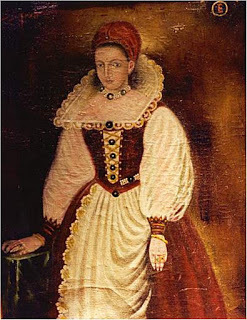 When Lutheran pastor, Istvan Magyari, openly accused the countess of mass murder at the Royal Court in Vienna, King Matthias of Hungary took personal interest. Royal investigators arrived unannounced at the castle, and found macabre evidence everywhere, including starved and mutilated prisoners, and bloodless, dismembered corpses – Elizabeth herself was present and said to have been drenched in blood. As many as 300 witnesses came forward with damning testimonies, which included tales of murder and torture, not just at Csejte, but at her other properties in Sarvar, Nemetkeresztur and Pozsony. In total, the accusers claimed, some 650 women and girls had been lured to their deaths.
When Lutheran pastor, Istvan Magyari, openly accused the countess of mass murder at the Royal Court in Vienna, King Matthias of Hungary took personal interest. Royal investigators arrived unannounced at the castle, and found macabre evidence everywhere, including starved and mutilated prisoners, and bloodless, dismembered corpses – Elizabeth herself was present and said to have been drenched in blood. As many as 300 witnesses came forward with damning testimonies, which included tales of murder and torture, not just at Csejte, but at her other properties in Sarvar, Nemetkeresztur and Pozsony. In total, the accusers claimed, some 650 women and girls had been lured to their deaths.There was no possibility of refuting such a tide of evidence, and at their trial in 1611, all the malefactors were found guilty. On conviction, Semetesz and Jo were mutilated and then burned at the stake, Ujvary was beheaded and Benicka (who was regarded as a simpleton) imprisoned for life. Elizabeth herself was walled into a room in her own castle, where she lingered for four terrible years before dying from unknown causes.
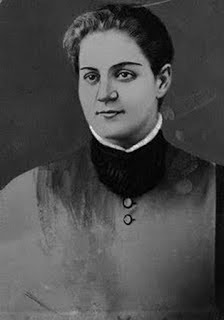 JANE TOPPAN (the Angel of Death)Some medical murderers regard themselves as mercy killers, the benign hand of God snuffing out the pain of their terminally-ill patients. Others seek to profit from their crimes, talking their ailing and confused charges into leaving them generous bequests before ending their lives prematurely.
JANE TOPPAN (the Angel of Death)Some medical murderers regard themselves as mercy killers, the benign hand of God snuffing out the pain of their terminally-ill patients. Others seek to profit from their crimes, talking their ailing and confused charges into leaving them generous bequests before ending their lives prematurely.But Jane Toppan, who in terms of numbers was surely one of the worst ever, had entirely different motives, seemingly deriving great sexual pleasure from her crimes and the sense of power they endowed her with.
After a difficult childhood spent in the Boston care home where she was born in 1857, Honora Kelley was eventually taken on as an indentured servant by the kindly Toppan family, who educated her and treated her so well that she renamed herself Jane Toppan. On reaching young womanhood in 1885, she was well-equipped to deal with the world, and commenced a potentially lucrative nursing career at Cambridge Hospital – where she almost immediately began to torture certain selected patients, experimenting on them with deadly cocktails of morphine and atropine, bringing them to the point of death and back again (if she possibly could), at the same time climbing into bed and holding them close as they struggled for their lives.
Amazingly, though numerous of her patients died through this horrible process, her murderous hand remained undetected for years. In fact, as she moved from post and post, her career seemed to flourish. Though occasionally disciplined for prescribing drugs recklessly and even suspected of committing occasional thefts, Jane was an attractive woman and seemingly very competent, and as such was well-regarded by her employers. In due course, she found herself earning good money as a private nurse catering to some of Boston’s wealthiest families (whom she also proceeded to decimate).
If the misuse of prescribed opiates was the means by which Jane Toppan could exert an enjoyable control over life and death, she was also pragmatic when it came to murder, despatching rivals and enemies with a variety of other poisons, but gradually becoming careless in her overconfidence. When, in 1901, she murdered four members of the highly respected Davis family in the space of six weeks, suspicion was finally aroused, and a post mortem revealed masses of poison in the victims’ systems.
Taken into custody, Toppan confessed to 31 murders, claiming that her ambition was “to have killed more people than any other man or woman who ever lived”. And she’d certainly made a good fist of this, as despite her confession, evidence later came to implicate her in at least 70 poisoning deaths.
Judged insane, Toppan was spared the death penalty and incarcerated in a lunatic asylum, where she only died in 1938 at the age of 84.
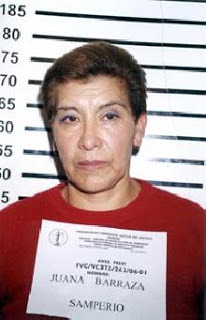 JUANA BARRAZA (the Old Lady Killer)Juana Barraza is something of an exception on this list as her crimes are contemporary. She is still very much alive and if she was at liberty would be more than capable of continuing her reign of terror.
JUANA BARRAZA (the Old Lady Killer)Juana Barraza is something of an exception on this list as her crimes are contemporary. She is still very much alive and if she was at liberty would be more than capable of continuing her reign of terror.She also most closely resembles the typical male serial killer in that she actively trawled for her victims along the backstreets and run-down neighbourhoods of dingy inner city districts, focussing on a particularly vulnerable and undefended section of society, planning each attack carefully and then striking with extreme savagery.
The murders first began in the late 1990s, when a succession of elderly ladies in Mexico City, all of whom lived alone, generally in run-down parts of town, were found in their homes, bludgeoned and garrotted, and usually having been robbed.
The subsequent police investigation was hampered from the start by factors that were almost beyond the authorities’ control. Even as built-up urban districts go, Mexico City suffers from inordinately high levels of violent crime. Robbery/homicide is a sadly common occurrence, so there was extreme difficulty establishing which crimes were part of the series and which were unconnected to it. Even as late on as 2005 there was uncertainty about how many victims could accurately be attributed to La Mataviejitas (or ‘the Old Lady Killer’), with estimates varying from as few as 11 to as many as 49.
Another complicating factor came in the many witness statements that detectives gathered, which suggested that on more than one occasion a butch-looking female had been seen running from the premises. This was potentially a good lead, but it was a clear mistake by the police to assume that this meant the murderer was a transvestite. In no case was there evidence of sexual assault, which ought to have lessened the possibility the culprit was male. By the same token, whoever the killer was, he/she had never needed to break into the victims’ homes, but had always been invited, which implied a lack of perceived threat and thus made it even more likely the offender was female. The subsequent city-wide swoop on the crossdressing community was, with hindsight, a colossal waste of time and resources.
The killer’s luck finally changed in 2006, when she was again sighted leaving the scene of a murder, but this time was apprehended nearby. Mexico City’s population celebrated on hearing that a suspect was in custody, but there was universal astonishment when that suspect’s identity was revealed.
Juana Barraza was known to her friends as a respectable, conservative woman who worked hard and cared for her family. While not exactly a household name, she also enjoyed some degree of fame as a semi-professional wrestler, whose masked persona in the ring was ‘the Silent Lady’. When arrested, she was in possession of fake identity cards variously naming her as a social worker, a nurse and a welfare officer, which explained how she had been able to con her way into the homes of her gullible victims.
Barraza’s own past was a depressing tale. Sold by her own mother as a child to an abusive man for the price of three bottles of beer, she’d grown up despising the memory of her single parent and determined to gain revenge on elderly ladies in whatever depraved way she could.
In custody, she admitted to only one of the murders, but was later convicted of 16 and sentenced to a minimum of 60 years in prison.
DELPHINE LALAURIE (the She-Wolf of Royal Street)
Delphine LaLaurie was vaguely similar to Elizabeth Bathory in that for quite some time her eminent position protected her from investigation, and also enabled her to acquire numerous, regular victims without attracting much attention. In her case, because she lived in New Orleans during the French Colonial era, these unfortunates were her own black slaves.
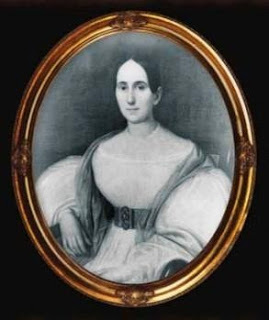 LaLaurie had similar appetites to Elizabeth Bathory, being insatiably cruel and sadistic. However, unlike Countess Dracula, many of the atrocities associated with LaLaurie are unsupported by factual evidence.
LaLaurie had similar appetites to Elizabeth Bathory, being insatiably cruel and sadistic. However, unlike Countess Dracula, many of the atrocities associated with LaLaurie are unsupported by factual evidence.This doesn’t mean they didn’t happen or that they have been exaggerated, but some of the ghastly stories we are about to discuss owe as much to myth as to fact. What is indisputably true is that Delphine LaLaurie was a rich New Orleans socialite of the early 19th century, and that in 1832 she built herself a palatial residence on Royal Street in the heart of the city’s stylish French Quarter (it is well preserved today, and can still be visited).
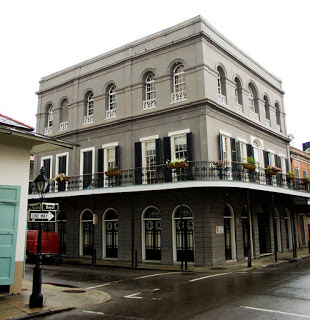 To all intents and purposes, LaLaurie maintained the image of a benevolent woman-about-town, who was ostentatious in terms of her wealth and active on the ball-room circuit, but who was also liberal in her views and a supporter of good causes. However, by about 1832, stories were rife in the neighbourhood that her slaves were in a pitiful condition, looking starved and often displaying signs of severe beatings. When a 12-year-old slave girl apparently preferred jumping to her death from an upper window in the Royal Street mansion than submit to a whipping by her mistress, there was an enquiry. Discovering that the savage and prolonged flogging of chained and underfed slaves was a regular event in LaLaurie’s household, she was cautioned and fined.
To all intents and purposes, LaLaurie maintained the image of a benevolent woman-about-town, who was ostentatious in terms of her wealth and active on the ball-room circuit, but who was also liberal in her views and a supporter of good causes. However, by about 1832, stories were rife in the neighbourhood that her slaves were in a pitiful condition, looking starved and often displaying signs of severe beatings. When a 12-year-old slave girl apparently preferred jumping to her death from an upper window in the Royal Street mansion than submit to a whipping by her mistress, there was an enquiry. Discovering that the savage and prolonged flogging of chained and underfed slaves was a regular event in LaLaurie’s household, she was cautioned and fined. But it was only in 1836 when a fire at the house exposed the full horror of what was happening there.
A 70-year-old cook confessed to the police that she had set the flames deliberately to avoid being taken to her mistress’s upper room, from where no-one ever returned. An investigation of this upper room discovered four corpses and at least seven slaves confined in a variety of torture devices, many on the point of death. Some had been lashed to the point where they’d literally been flayed. One had been disembowelled, one had had his eyes gouged out, and another’s lips had been sewn together. Two female captives had suffered particularly awful cruelty; the first had lost all four of her limbs to axe-blows, and the stumps had been cauterised, turning her into a human caterpillar. The other’s limbs had been broken and deliberately re-set at strange angles, so that she resembled a crab.
A full-scale excavation of the property followed, and about 100 corpses – all bearing similar marks of murder and mutilation – were recovered from the courtyard alone.
Again, it’s worth pointing out that much of this gory and sensational detail was reported in later pamphlets rather than at the time – some evidence suggests that only two murder victims were in fact disinterred from the courtyard – but whatever facts escaped into the public domain back in 1836, it caused a riot, a mob sacking LaLaurie’s house and driving the evil woman and her family into headlong flight.
Ultimately, whatever actually happened in New Orleans, Delphine LaLaurie avoided real justice, successfully emigrating to France, where she died in her late 60s … from natural causes.
THRILLERS, CHILLERS, SHOCKERS AND KILLERS …
An ongoing series of reviews of dark fiction (crime, thriller and horror novels) – both old and new – that I have recently read and enjoyed. I’ll endeavour to keep the SPOILERS to a minimum; there will certainly be no given-away denouements or exposed twists-in-the-tail, but by the definition of the word ‘review’, I’m going to be talking about these books in more than just thumbnail detail, extolling the aspects that I particularly enjoyed … so I guess if you’d rather not know anything at all about these pieces of work in advance of reading them yourself, then these particular posts will not be your thing.
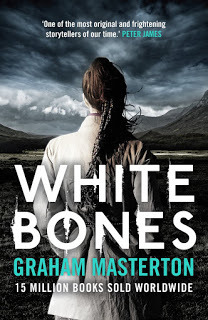 WHITE BONES
by Graham Masterton (2003)
WHITE BONES
by Graham Masterton (2003)When the disassembled skeletons of 11 women are uncovered in a farm field near Cork, in southern Ireland, Detective Superintendent Katie Maguire of the Garda Síochána is put on the case, but initially it seems that there is no cause for panic. The bones, which though marked and laid out as if for ceremonial purposes, are old, possibly relating to the disappearances of a number of women and girls back in 1915. No-one can be prosecuted now, and so there is no great pressure – until a rumour starts to spread among local Republicans that the crime may have been committed by British forces in retaliation against IRA bombings, which causes several jitters at government level.
Maguire, aided by her surly sidekick, DI Liam Fennessy, has her doubts about this. These long-ago killings appear to be steeped in druidic Irish lore; by the looks of it, they were human sacrifices made in an effort to raise Mór-ríoghain, a Celtic goddess of extreme power and malevolence. It seems unlikely that even the most demented British squaddie would have possessed the knowhow to perform such a rite. But then, very unexpectedly, the situation takes a turn for the worse – a hitchhiking American girl is abducted in the neighbourhood, and subjected to the same appalling death: she is literally skinned, gutted and dismembered while still alive, and her constituent parts ranged ritualistically on land belonging to the same farm.
Maguire and her team are perplexed. It can hardly be the same murderer, with 88 years passed. Clearly someone else has picked up the gauntlet. An arrest is duly made – a travelling man with a long record of violent, sexual crime and a deep knowledge of witchcraft. He seems a viable suspect until a second abduction occurs while he’s in custody. This time it’s a local college girl. Maguire suddenly finds herself in a race against time to prevent a further atrocity. As if that isn’t difficult enough, her home-life is a mess. Her father, a former ace detective himself, is old, lonely and occasionally vague, while her wheeler-dealer husband, Paul, is constantly in trouble with the local underworld. On top of that, Fennessy turns ever more truculent, convinced that Maguire was promoted ahead of him simply because she’s a woman.
When the beautiful and elegant Lucy Quinn, an academic specialising in mythology, arrives from the States to advise the Garda, Maguire finds a kindred spirit and a like-mind. But Quinn’s revelations about the case offer no real comfort; these current crimes, she concludes, are a continuation of the 1915 sacrifice, and it isn’t complete yet. Whoever the current culprit is, he only needs one more life and then he’ll be able to summon Mór-ríoghain, and who knows what will happen then?
Maguire doesn’t believe in Mór-ríoghain – she is convinced they are dealing with a madman – but Quinn appears genuinely alarmed by the prospect. Each new day, it seems, there are ever more urgent reasons for bringing this sadistic murderer to book as quickly as possible …
One thing you always know you’ll get when reading a Graham Masterton book – or you ought to know it – is that it’ll pull no punches when it comes to the violence and gore. Masterton traded for years as one of Britain’s most successful horror writers, and it was full-on, unashamed horror, beautifully written and meticulously researched (there has often been a mythological content in Masterton’s work), but also filled with explicit sex and intense, visceral gruesomeness.
If that is your thing, or if you simply don’t mind it – then you’ll thoroughly enjoy White Bones . But if it isn’t, then you’ll need to tread carefully.
Because without doubt, this is one of the grisliest crime novels I’ve ever read, if not the grisliest. In fact, I’m not surprised that quite a few reviewers online have described it as a horror novel rather than a crime thriller. That isn’t true – the viciousness displayed by the villains in this book is beyond the pale and the reader is spared not a single detail of it, while there is more than a whiff of the supernatural, but this is still, at heart, a murder investigation and a police procedural.
That said, the scenes in which protracted and barbaric surgery is performed on living people without any kind of anaesthetic are prolonged and torturous, as much for the reader as for the victims. And a couple of times, even I – who have a foot in both the horror and the thriller camps – found it difficult to read on.
But Masterton’s work has never been for the faint-hearted, and from this evidence, he clearly intends to tackle his crime thrillers with the same head-on gusto that he does his horror work. So we’re talking truly ghastly crimes graphically illustrated, outlandish villains who are both mad and bad at the same time – Eamon Collins is one of the scariest gangsters I’ve encountered in crime fiction to date, and he only has a small role – and all of it taking place on a gloomy, despair-ridden landscape. County Cork is a beautiful corner of Ireland, but it’s also bleak (especially in this book), and it doesn’t half rain there.
Did I enjoy it, though?
You bet I enjoyed it.
The goriness aside – which as I’ve said, did disturb me a little – I found it a compelling read. The gradual interweaving of the two mysteries, the murder case from 1915 and the current one, is excellently managed. The cops’ desperate pursuit of a remorseless but bewildering assailant is all quite believable, especially as they are constantly interfered with by politicians, distracted by other equally violent cases, and struggling with domestic difficulties in their homes.
The backdrop of mysticism is taken much further than other crime novels I’ve read that are based around ritual and sacrifice, but it is deftly handled. Though the author is clearly intoxicated by the idea of ‘the Invisible Kingdom’, and very, very tempted to take us there – on occasion he comes infinitesimally close – ultimately he behaves himself and we never stray from the real world. The magic is all in the mood and the atmosphere, but the vein of dark superstition that runs through this book is both fascinating and shudder-inducing.
Meanwhile, Kate Maguire makes for a very appealing heroine. If I had any criticism it would be that towards the end of the book she seems a little weak; given that she’s risen to the rank of Detective Superintendent – the first in Ireland – you might have expected a more robust personality. But to be fair, she suffers all kinds of personal disasters during the course of this narrative, which by the end have left her a shell of the woman she was.
White Bones (formerly published as A Terrible Beauty and Katie Maguire ) gets my strongest recommendation. Sure, it makes grim reading and the ending is maybe a bit of a right-turn, but it’s completely soaked in the atmosphere of its locations and peopled with grotesque but wonderful characters, while the dialogue is juicy and fast-moving, and there always seems to be a new menace just around the corner – you can’t afford to relax for one minute.
I wouldn’t say I didn’t guess the main culprit beforehand, but it was late in the day and it didn’t put a dampener on my enjoyment. A greatly entertaining if very, very dark crime thriller.
I often like to end these book reviews with my own picks for who’d play the leads if a film or TV version was ever made. If that was the case here, it would strictly be of the X-rated variety, but hell, I hope that wouldn’t put them off. Anyway, just for fun, here are my casting selections:
Detective Superintendent Katie Maguire – Heather GrahamDetective Inspector Liam Fennessy – Cillian MurphyLucy Quinn – Tricia HelferEamon Collins – Gabriel ByrnePaul Maguire – Damien O’Hare
This week's imagery is as follows, top to bottom: Cathy Bates as Delphine LaLaurie in American Horror Story; Strangers by Paul Finch; a masked and armed female figure photographed by a roadside in New Zealand earlier this year (though this wasn’t a murder suspect, most likely just a prankster); contemporary newspaper coverge of Jeanne Weber’s crimes; Ingrid Pitt as Elizabeth Bathory, Hammer style; a contemporary portrait of Elizabeth Bathory; a contemporary portrait of Jane Toppan; a police mugshot of Juana Barraza; a contemporary portrait of Delphine LaLaurie; the LaLaurie mansion today;White Bones by Graham Masterton.
Published on September 26, 2016 00:48
September 21, 2016
New cop Lucy hits mean streets tomorrow
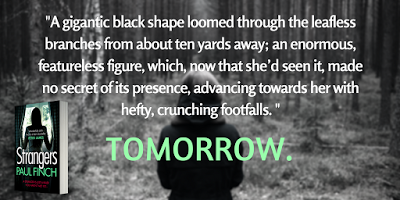
It’s a big week for me, this week. One of the biggest I’ve had in my time as a professional author. In short, my sixth crime novel – STRANGERS (the first in the Lucy Clayburn series) – is published tomorrow. Yes, as the poster says – TOMORROW. So, I thought I’d use this opportunity to give you a bit of a rundown on everything that’s happened so far and is hopefully about to happen. Before we proceed with that, if you’ve tuned in to read my review of James Carol’s truly horrific crime thriller, BROKEN DOLLS, you’ll find it, as usual, at the lower end of this post. But in the meantime, back to STRANGERS ...
 I can honestly say that this is a different kind of book for me and a departure from the norm. You might respond with: “No, it isn’t. It’s another dark crime thriller.” Well, there’d actually be a bit of truth in both those assertions.
STRANGERS
definitely occupies my preferred territory: a lone detective trawling the urban night, meeting criminals and crazies at every turn, with the ultimate goal of defeating and arresting a relentless and deranged killer. But if you take a chance on it, I think you’ll soon find that there is plenty blue water between this one and the Heck investigations. All that said,
STRANGERS
was originally born from an idea I first pitched to my publishers, Avon (HarperCollins) for a DS Heckenburg novel concerning a murderess known to the press as ‘Jill the Ripper’.
I can honestly say that this is a different kind of book for me and a departure from the norm. You might respond with: “No, it isn’t. It’s another dark crime thriller.” Well, there’d actually be a bit of truth in both those assertions.
STRANGERS
definitely occupies my preferred territory: a lone detective trawling the urban night, meeting criminals and crazies at every turn, with the ultimate goal of defeating and arresting a relentless and deranged killer. But if you take a chance on it, I think you’ll soon find that there is plenty blue water between this one and the Heck investigations. All that said,
STRANGERS
was originally born from an idea I first pitched to my publishers, Avon (HarperCollins) for a DS Heckenburg novel concerning a murderess known to the press as ‘Jill the Ripper’. You see, it had occurred to me that for ages we’ve been reading (and writing!) crime novels in which the hapless victims are nearly always female and their cruel oppressors invariably male. In many ways this is a reflection of tragic reality. In real life, most serial sex killers are men and most of their victims women. It’s a horrible and shameful aspect of human ‘civilisation’, but this book is fiction, and from the outset I’d thought: “Wouldn’t it make a change if we inverted things a little … if this time we made men the victims of a merciless female predator?”
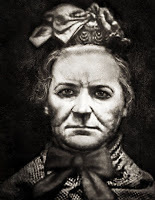
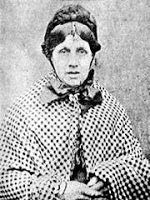 It would be newish ground, for sure. There have, of course, been several high profile female serial killers, but usually these tend to be poisoners, baby farmers or ‘black widow’ types. Names like Mary Ann Cotton and Amelia Dyer (left to right in that order) belong in all our halls of infamy. But even so, very few women criminals have ever been convicted as wandering sex-killers.
It would be newish ground, for sure. There have, of course, been several high profile female serial killers, but usually these tend to be poisoners, baby farmers or ‘black widow’ types. Names like Mary Ann Cotton and Amelia Dyer (left to right in that order) belong in all our halls of infamy. But even so, very few women criminals have ever been convicted as wandering sex-killers.As I say, this was originally intended to be a Heck novel, but when I pitched the idea to my gaffers at HarperCollins, they thought it would make for an even more interesting twist if a female detective was put on the case.
Well … this was as cool as it got. Because it gave me an opportunity to resurrect a character I’d first devised as long ago as 1993.
Back in those distant days, Lucy Clayburn was the central figure of a TV drama I was trying to sell called DIRTY WORK, which concerned a young woman detective in Manchester who was investigating a series of murders of prominent criminals, only to uncover a web of police corruption and collusion. I was still attached to THE BILL at the time, and so DIRTY WORK got onto quite a few desks. It was optioned fairly quickly, and a Northwest actress who in the early ’90s was the star turn in one of our popular soap operas was very interested in playing the lead. But alas, in the long run it all came to nothing.
In due course, the story itself became obsolete as it had centred around several notorious miscarriages of justice in the UK, which were big news at the time but soon faded into history. But the character of Lucy Clayburn was one I liked very much – a tough Manchester lass from a blue-collar background, not necessarily with a chip on her shoulder but driven by her impoverished upbringing to make a real mark on society, and a good mark too because the most influential person in her life had always been her hardworking single mum.
At the time I filed Lucy away with the intention of bringing her back at some future date, but I could never have imagined that 23 years would elapse before I finally did. But anyway, here we were in 2015, now with a completely different storyline, but one that I felt fitted Lucy like a glove.
I’d like to say that because everything was going so swimmingly, the book wrote itself. But that wouldn’t be true at all (is it ever?). As this new story wouldn’t just see Lucy exercising her investigative muscles, but going undercover as a prostitute to pursue suspects through some of the city’s grimiest backstreets and sleaziest brothels, the first thing I had to do was wise up on what this would actually entail.
 I’m an ex-copper myself, but I never did anything of that nature. Thankfully, a good mate of mine, fellow wordsmith Ash Cameron – author of
CONFESSIONS OF AN UNDERCOVER COP
– did. She was a London detective for many years, and undertook this sordid and dangerous assignment on several occasions. She gave me the full skinny, not just the complex legalities, but also the constant menace and mundane horrors the girls involved encountered on a daily basis, not to mention the personal conflicts they suffered and the way they had to immunise themselves against the misery and hopelessness around them.
I’m an ex-copper myself, but I never did anything of that nature. Thankfully, a good mate of mine, fellow wordsmith Ash Cameron – author of
CONFESSIONS OF AN UNDERCOVER COP
– did. She was a London detective for many years, and undertook this sordid and dangerous assignment on several occasions. She gave me the full skinny, not just the complex legalities, but also the constant menace and mundane horrors the girls involved encountered on a daily basis, not to mention the personal conflicts they suffered and the way they had to immunise themselves against the misery and hopelessness around them.It was quite an eye-opener, much of which, I think, has found its way into STRANGERS .
There was a bit of kerfuffle when my first draft was delivered. Avon promptly decided to reshuffle the schedule. The next Heck book in line for publication, at the time titled THE BURNING MAN, was moved back a year (and retitled ASHES TO ASHES). This was a bit of a surprise and a disappointment to some of my readers. However, most, I now hope, are onside, having seen that this was to accommodate a new book, a new character and the commencement of a new series, one I intend to see run parallel with Heck (you haven’t seen the end of Heck yet, so don’t worry on that score).
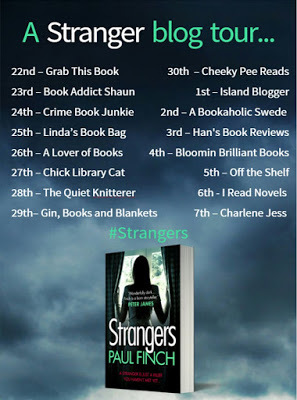 STRANGERS
will hit the bookshelves tomorrow, which date will also see us start out on a massive blog-tour, the first stop of which, as you can tell from the itinerary posted here, will be
GRAB THIS BOOK
. For regular daily updates on this tour, by the way, just look me up on Facebook and/or Twitter.
STRANGERS
will hit the bookshelves tomorrow, which date will also see us start out on a massive blog-tour, the first stop of which, as you can tell from the itinerary posted here, will be
GRAB THIS BOOK
. For regular daily updates on this tour, by the way, just look me up on Facebook and/or Twitter.In other Lucy Clayburn-related news, I have a couple of radio interviews due very soon: one with Hannah Murray on The Book Show at Talk Radio Europe, and one with Becky Want at BBC Radio Manchester. Both of these have yet to air, but again, if you hunt me down on Twitter or Facebook, you’ll see that I give advance notice about dates, times etc. Equally fun was a podcast I did for HarperCollins with Ash Cameron, in which we discuss the gauntlet of risks she ran while going undercover among sex-workers in her role as a police detective. It’s not all grim and ghoulish, though. If you tune in – and again I’ll give you the heads-up as and when – you’ll hear that we had a few laughs too.
Okay, well that’s it so far. As I say, shamelessly plugging my own book yet again, STRANGERS will be in your local bookshop tomorrow (I hear that certain Asda stores are already selling it!), and will be available from all the usual retail outlets online.
Now, on a not unconnected note, please feel free to check out my thoughts re. another crime-fighter in pursuit of a deadly murderer in this week’s edition of …
THRILLERS, CHILLERS, SHOCKERS AND KILLERS …
An ongoing series of reviews of dark fiction (crime, thriller and horror novels) – both old and new – that I have recently read and enjoyed. I’ll endeavour to keep the SPOILERS to a minimum; there will certainly be no given-away denouements or exposed twists-in-the-tail, but by the definition of the word ‘review’, I’m going to be talking about these books in more than just thumbnail detail, extolling the aspects that I particularly enjoyed … so I guess if you’d rather not know anything at all about these pieces of work in advance of reading them yourself, then these particular posts will not be your thing.
 BROKEN DOLLS
BROKEN DOLLS by James Carol (2014)
Consultant behavioural science profiler, Jefferson Winter, has a unique insight into the minds of serial killers … mainly because he himself was fathered by one. When young Jefferson watched his evil genius parent die by lethal injection, he had no idea that his path in life was set.
“We’re the same,” the malevolent old man told his son through the bullet-proof viewing port of the execution chamber seconds before the deadly drugs pitched him into the next world. But this wasn’t entirely true, because, expert though he soon became in the ways of depraved murderers, the adult Jefferson eventually joined the good guys’ team. And though he commenced his career as a profiler with the FBI, he now carries the good fight all over the globe – in short he’s a profiler-for-hire, and a top-gun freelancer when it comes to cracking the psychological makeup of the world’s worst violent offenders.
In Broken Dolls , his very first outing, he’s been summoned to London by an old mate, Detective Inspector Mark Hatcher, who is struggling with a particularly distressing case.
An unknown maniac has been abducting women, shaving their heads, torturing them at his leisure and then lobotomising them, releasing them back onto the streets as wandering relics of the people they once were: broken dolls with no lives left to call their own.
Even Winter, who’d thought he had seen it all, is taken aback by the horror of this enquiry. There are four victims to date – a quartet of truly tragic cases. Obviously none of them are able to help with the details of their abductor. But then another woman goes missing; attractive but bored housewife, Rachel Morris, who disappeared on a blind date with a strange personality she encountered online.
Winter, in company with the beautiful and spirited DS Sophie Templeton, finds himself racing against the clock to prevent the zombification of another innocent victim, though on this occasion it’s entirely possible that the kidnapper may have bitten off more than he can chew – because Morris is the estranged daughter of London mob boss Donald Cole, who is desperate to assist in the search for her any way he can. This certainly interests Winter, but whether it will prove to be a help or a hindrance remains to be seen.
Meanwhile, Rachel Morris finds herself imprisoned in a purpose-built torture chamber. The debonair chap she was secretly on her date with, the aptly-named ‘Cutting Jack’ – who has a penchant for unfaithful wives – is determined to put her through a living hell before finally taking her mind and her memories away …
Broken Dolls is a different kind of crime thriller from the norm in that we see things through the educated eyes of a criminal profiler rather than the instincts and street-smarts of a hard-assed detective. Some British reviewers have commented negatively on this; Jefferson Winter – a rather smug character, it has to be said, who doesn’t even carry a badge any more – popping over to the UK and showing Scotland Yard’s best how the job should really be done. But I didn’t get that feeling (and James Carol is a British writer, so I suspect his use of an American hero is more about gaining his books an international profile than about teaching the Brits what’s what). In any case, it all works. Quantico was the birthplace of modern-day offender profiling, and the FBI are still recognised as world-leaders in the field, so in that regard nothing jars for me. Plus, as I intimated previously, the approach in this novel is all quite original.
Instead of seeing doors kicked down, suspects leaned on and forensic clues painstakingly gathered, we see Winter dashing around at breakneck pace but also constructing a gradual and detailed psychological portrait of his anonymous opponent. The author has clearly done his research here – it all feels very authentic as he slowly and convincingly gets into the mind of his demented antagonist.
Which brings me onto the book’s personnel.
Jefferson Winter is an unusual kind of good guy. He’s affable, a straight-talker and driven to do the right thing – all stuff we like. But there are oddities too. Though he’s only young, thanks to a physiological anomaly he has a full head of snow-white hair – and yet he’s no white knight. It is hinted all the way through the book that Jefferson has inherited some of his father’s genes, and he constantly needs to battle against baser instincts. He particularly lusts after Sophie Templeton, though thankfully keeps most of that in check.
Needless to say, this is an aspect of the book that hasn’t been to every reader’s taste – some have even labelled it ‘misogynistic’. But I disagree with that. Winter is a single guy who likes gorgeous girls, which I don’t consider to be particularly offensive. He also admires Templeton greatly for her detective skills, so it isn’t purely a physical attraction between them. However, his horrific start in life has affected him in other ways too. Winter is good enough at what he does to make a lucrative living as he hires himself out to one police force after another, yet deep down he is still frightened and uneasy about the state of his own mind, and his Sam Spade-esque bravado is primarily a disguise. He is nowhere near as self-assured as he may appear.
Templeton meanwhile is so sexily described (it’s a little overdone, if I’m absolutely honest) that you’re tempted to picture one of those impossibly well-coiffured lady cops you get in American TV dramas, but this is offset by her feisty nature and upper class tone, which juxtaposes nicely with the hardboiled Winter, and helps create a cool if somewhat unlikely crime-fighting duo.
As for the villain, Cutting Jack … he is without doubt one of the most twisted criminal lunatics I’ve yet come across in crime fiction, though this does lead me to one slight criticism: there is an awful lot of torture in this novel.
Protracted scenes of cruelty and pain don’t do a great deal for me, but by the same token I don’t think they’re completely unnecessary here. Broken Dolls is essentially a race against time – the killer already has his next victim in chains and is currently playing with her; at some point soon he’s going to hammer his orbitoclast through her eye-socket and it’ll all be over. If we were purely to watch Winter and Templeton as they race about the snowy London streets doing everything they can to close ground on a faceless madman, it wouldn’t be half as effective. As things are, though it isn’t pleasant dwelling on the pain of doomed captives, the terror and tension in these scenes is almost tangible – every time the maniac enters through the dungeon door, you wonder if this is going to be it for housewife Rachel. And it isn’t just torture that Cutting Jack indulges in. Once you’re in his grasp, all kinds of unexplainable weirdness occurs – but I won’t say any more about that for fear of spoiling things. Put it this way, there are surprises galore in this narrative, and very few of them are nice.
I strongly recommend Broken Dolls to lovers of hard, dark crime fiction. It’s no comfortable read – not by any means, but even so I rattled through the pages, all the time hearing an imaginary clock ticking down to what might be yet another ghastly incident. If you’ve got the stomach for it, it’s quite a rush.
I’m reliably informed that a US TV show following Jefferson Winter’s various exploits is already in development, but maybe, if I’m bold enough, I can get in early with some casting suggestions. As usual just for the fun of it, here are my personal picks for the lead roles in Broken Dolls:
Jefferson Winter – Damien LewisDS Sophie Templeton – Jenna Louise ColemanDI Mark Hatcher – Shane Ritchie Rachel Morris – Katy CavanaghDonald Cole – Ray WinstonCutting Jack – James Frain
Published on September 21, 2016 00:33
August 24, 2016
When stranger danger becomes all too real
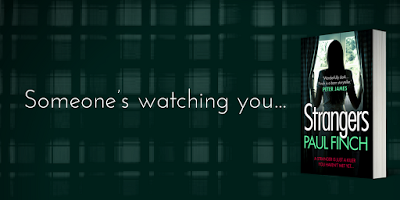
I have a few interesting bits and pieces to report this week.
To start with, we are approximately one month away from the launch of my next novel, STRANGERS , and as such the publicity machine is in full flow. You can expect cool banners, like the one above, to start proliferating across social media in the next few days. In addition, I have several public appearances – chats, interviews, book signings etc – lined up for the months ahead, but more about that shortly. In addition this week, as usual, I’ll be discussing someone else’s dark fiction. Today I’ve opted for JG Ballard’s chilling and prophetic crime thriller, RUNNING WILD . As always, my thoughts on the matter and a full review of it can be found at the lower end of this post.
Before we get to that, I’ve been quite fascinated this last couple of days by some of the mysterious activities indulged in by certain marketing people of my acquaintance. I’m talking about my publishers at Avon Books and HarperCollins, who are nothing if not ingenious when it comes to attracting the interest of bloggers, reviewers and the like when a new book is about to get published.
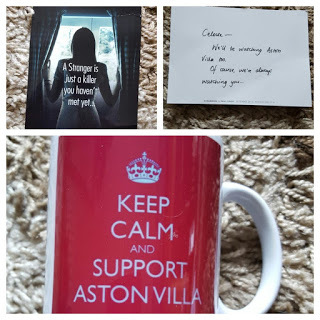 I’m not entirely sure what kind of Machiavellian minds are at work here, but only this week the charming Celeste McCreesh, who writes the
CELESTE LOVES BOOKS
blogspot, a big Aston Villa fan, received an intriguing package through the post, which didn’t just contain a review copy of
STRANGERS
, but also a personalised Aston Villa mug and an anonymous postcard advising her to keep on watching Villa because someone else would be watching her …
I’m not entirely sure what kind of Machiavellian minds are at work here, but only this week the charming Celeste McCreesh, who writes the
CELESTE LOVES BOOKS
blogspot, a big Aston Villa fan, received an intriguing package through the post, which didn’t just contain a review copy of
STRANGERS
, but also a personalised Aston Villa mug and an anonymous postcard advising her to keep on watching Villa because someone else would be watching her …Whether you consider such an approach fiendishly clever or just plain spooky, you can’t deny that it will have caught the reviewer in question’s full and unswerving attention.
I can only take my hat off to the crafty characters behind this ploy.
Still on the subject of STRANGERS , here are a few possible dates for the diary if you fancy some face-time with me or don’t mind tuning in to a bit of gossip on the radio. (I don’t expect you to come stampeding to these events, by the way, but you know, if you have the inclination …)
 Sometime in early September – I don’t have the exact dates of transmission for either of these yet – I’ll be interviewed on the weekly Book Show on
TALK RADIO EUROPE
by Hannah Murray, and on
BBC RADIO MANCHESTER
by Becky Want (pictured). If you fancy listening to either or both of these, keep checking my Facebook and Twitter feeds. I’ll post the exact details as soon as I get them.
Sometime in early September – I don’t have the exact dates of transmission for either of these yet – I’ll be interviewed on the weekly Book Show on
TALK RADIO EUROPE
by Hannah Murray, and on
BBC RADIO MANCHESTER
by Becky Want (pictured). If you fancy listening to either or both of these, keep checking my Facebook and Twitter feeds. I’ll post the exact details as soon as I get them.Also in September, and again I’m not sure at this moment of the precise date and time of broadcast (so as above, check Facebook and Twitter), I’ll feature on a HarperCollins podcast, during which – in reflection of one of the themes in STRANGERS – I’ll be interviewing a real life former female police detective, who regularly went undercover as a prostitute, looking to snare some of the worst and most violent elements in our society.
And now for those actual dates I promised …
From September 23 to 25 (Fri to Sun), I’ll be at FANTASYCON BY THE SEA at Scarborough. If you’re there and you fancy a chat, don’t be afraid to doorstop me in a corridor or in the hotel lobby (or for guaranteed more positive results, offer to buy me a pint in the bar, hehehehe).
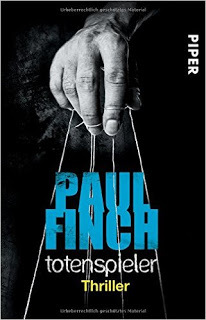 On Thursday September 29, I’ll be at Waterstones on Deansgate in the very centre of Manchester, where I’ll do a quick reading from
STRANGERS
(there’ll be copies on sale there too), will chat about it afterwards and then take any questions and sign any books that get put in front of me. This will be a particularly enjoyable and emotional event, I reckon, as
STRANGERS
is set in Manchester so we should all feel home from home.
On Thursday September 29, I’ll be at Waterstones on Deansgate in the very centre of Manchester, where I’ll do a quick reading from
STRANGERS
(there’ll be copies on sale there too), will chat about it afterwards and then take any questions and sign any books that get put in front of me. This will be a particularly enjoyable and emotional event, I reckon, as
STRANGERS
is set in Manchester so we should all feel home from home.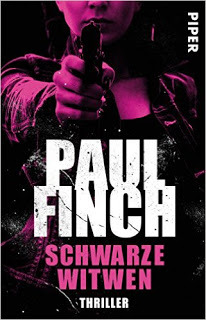 In late October, I’ll be appearing two nights in Germany as part of the
MORD AM HELLWEG
festival. On Saturday October 29, I’ll feature in the international crime thriller night at Hagen, and on Sunday October 30 at the Cultural Centre in Darmstadt with other
PIPER
crime authors.
In late October, I’ll be appearing two nights in Germany as part of the
MORD AM HELLWEG
festival. On Saturday October 29, I’ll feature in the international crime thriller night at Hagen, and on Sunday October 30 at the Cultural Centre in Darmstadt with other
PIPER
crime authors. Again, there will be readings, discussions and signings.
Check out these spiffing covers from PIPER for the German translations of my most recent Heck novel and of course for STRANGERS - that’s the one emphasising girl-power.
On Saturday November 19, we’re back in Manchester, where I’m honoured to occupy the lead author slot at the CHORLTON BOOK FESTIVAL. The event will take place at Chorlton Library (commencing sometime between 7 and 8pm – sorry, nothing firmer on that just yet), and again will include a reading, a chat, a Q&A and any signings the audience deems necessary.
So there we are. A busy autumn beckons. It would be great fun to hook up with a few readers in the process, and maybe put some faces to names at long last. *
THRILLER, CHILLERS, SHOCKERS AND KILLERS ...
An ongoing series of reviews of dark fiction (crime, thriller and horror novels) – both old and new – that I have recently read and enjoyed. I’ll endeavour to keep the SPOILERS to a minimum; there will certainly be no given-away denouements or exposed twists-in-the-tail, but by the definition of the word ‘review’, I’m going to be talking about these books in more than just thumbnail detail, extolling the aspects that I particularly enjoyed … so I guess if you’d rather not know anything at all about these pieces of work in advance of reading them yourself, then these particular posts will not be your thing.
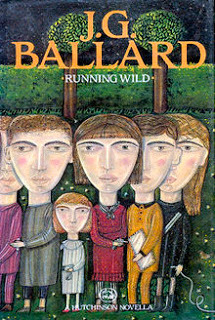 RUNNING WILD
RUNNING WILD
by JG Ballard (1988)
Pangbourne Village is classic ‘stockbroker belt’ suburbia, a gated community in the heart of the English Home Counties; green, clean and exclusively inhabited by wealthy, well-heeled couples on whose pampered, expensively-educated children all the gifts that money can buy are bestowed. In Pangbourne, privilege is an inalienable right but ‘merited’ by the liberal attitudes enforced there. It is a model society for a new middle class and politically correct Britain. And similar purpose-built communities are now springing up all along the Thames Valley. This is the future for those who can afford it.
And then something astonishing and horrible happens.
With swift, commando-like precision, an early morning attack is launched on Pangbourne, and all the adults – not just the residents, but their staff and security guards as well (32 in total!) – are brutally murdered, and all the children (13) are kidnapped. No ransom demands follow, and there is minimum definitive evidence to indicate any obvious explanation.
After a massive police enquiry fails, the Home Office appoints top criminal psychologist Richard Greville to investigate, in company with the dour but very experienced Detective Sergeant Payne.
This ‘chalk and cheese’ and yet unexpectedly like-minded duo launch a very thorough assessment of the crime, both in terms of the forensics and the psychology. Note is taken of the many murder methods employed, which are varied and gruesome – from shooting, to bludgeoning, to electrocution, strangulation and crushing by car – and yet bewilderment prevails that such a swathe of horrendous crimes could all occur in such a short time-frame. How many murderers would it have taken to inflict such intense and targeted and yet widespread violence? What kind of mental state must they have been in? And just how organised and proficient at their craft would they need to be to pull it off so efficiently? And in God’s name, why did it happen?
Greville and Payne pursue all kinds of potential leads: a Hungerford Massacre-type ‘lone wolf’ killer; a crime syndicate assassination team; a terrorist group; a spec ops unit from a nearby army camp gone postal; and even the possibility of enemy agents acting on behalf of a malign foreign power. But none of these increasingly improbable possibilities pan out. The murdered residents of Pangbourne were model citizens in every sense of the word. Deep analysis of their lives uncovers no shady secrets, no hidden agendas.
The baffling case is almost broken when one of the children is found alive, though she is deranged and remains incoherent through shock. But at the same time, several rather curious facts finally start to emerge about Pangbourne Village itself. In many ways, the life its population led – particularly the children – was too good to be true. Everything they wanted they had. Their hermetically sealed world was perfectly ordered and protected by their moneyed parents. They knew nothing in their lives – literally nothing – but love and adoration, and as such, children from neighbouring communities thought them rather closeted and odd. And could it also be relevant that this idyllic little nirvana was imminently to feature in a BBC TV documentary about new modes of living? There was certainly a strange atmosphere in the village as this date approached, as if some kind of countdown had been activated.
Greville, something of a hard-headed calculating machine when it comes to putting facts together, starts to wonder if the secrets of these murders actually lie much closer to the victims’ homes than anyone had previously thought – unthinkably close as far as the previous investigation teams were concerned.
And then, very unexpectedly but with equal violence and ferocity, the killers strike again …
The first thing to say about Running Wild , this famously prophetic mystery from the pen of one of the UK’s most visionary writers, is that it’s no straightforward thriller. Or indeed a straightforward mystery.
Presented in the form of a dry, detailed, almost bullet-pointed account of the investigation from Greville to his Home Office paymasters, this not a traditional novel, nor a particularly long one – more a long novella really – and it doesn’t bother going greatly into character, preferring to concentrate on the means and motivation behind the crime, and of course, as always with Ballard, the subtext.
In truth, it is difficult saying a great deal about that without giving away too much of the plot, but it’s worth adding that the eventual explanation behind the horrific incident is more than a little bit unlikely, though this doesn’t matter because what the author is really addressing here are issues of isolation, elitism, collapse from within, identity loss, social engineering, social decay, neglect of reality by the chattering classes and so forth, and of course addressing them with great eloquence and his trademark touches of sardonic ‘Middle England’ humour.
Without doubt, Running Wild is a modern minor classic, deeply intriguing, easy-to-read and in many ways, if you’ve never read him before, an ideal introduction to the strange, disturbing and yet always coolly-appraised world of JG Ballard.
As usual – just for the fun of it – here are my selections for who should play the leads if Running Wild ever makes it to the movie or TV screen (and I’m amazed it hasn’t already, if I’m honest).
Dr. Richard Greville – Hugh BonnevilleDS Payne – Gwendoline Christie
(Okay, I know that in the book Payne is a bloke, but that isn’t necessary, and Ms. Christie would still be ideal in the role).
Published on August 24, 2016 04:36



